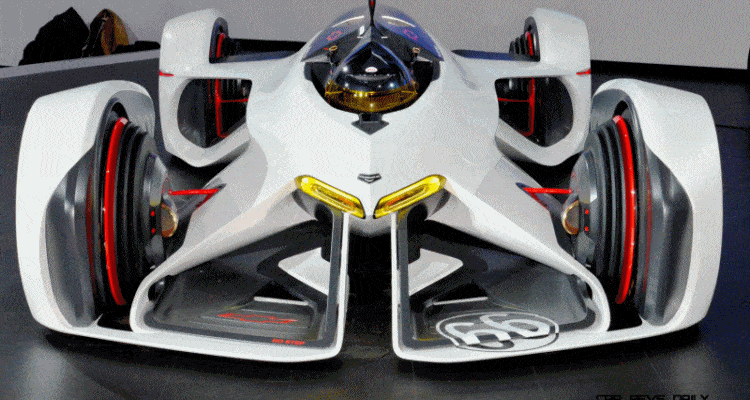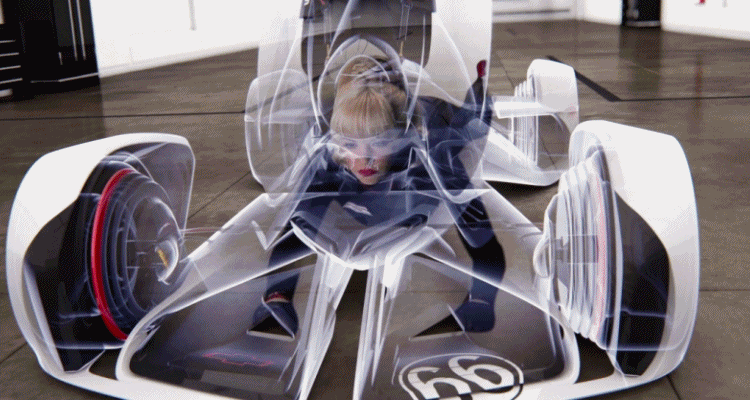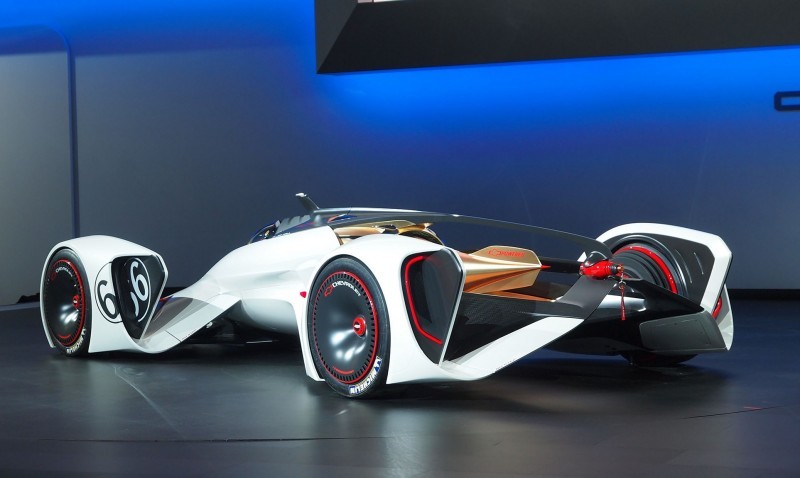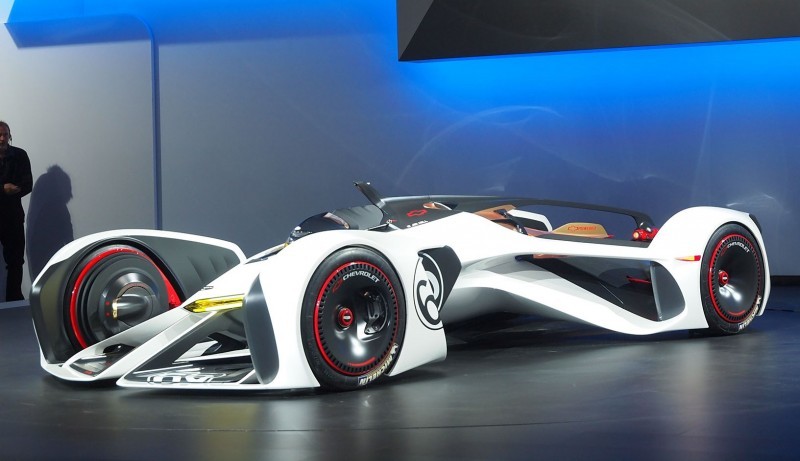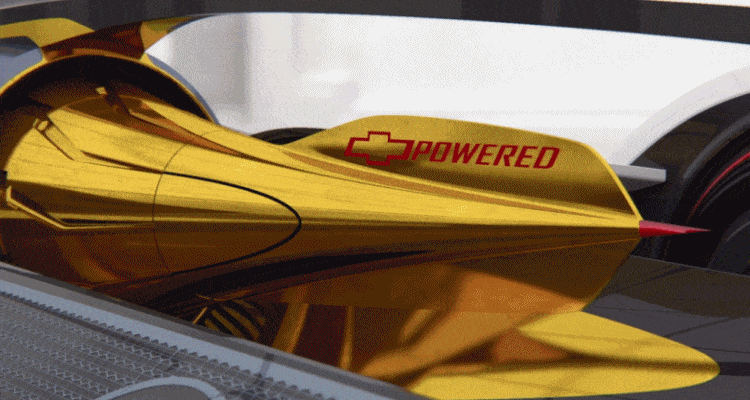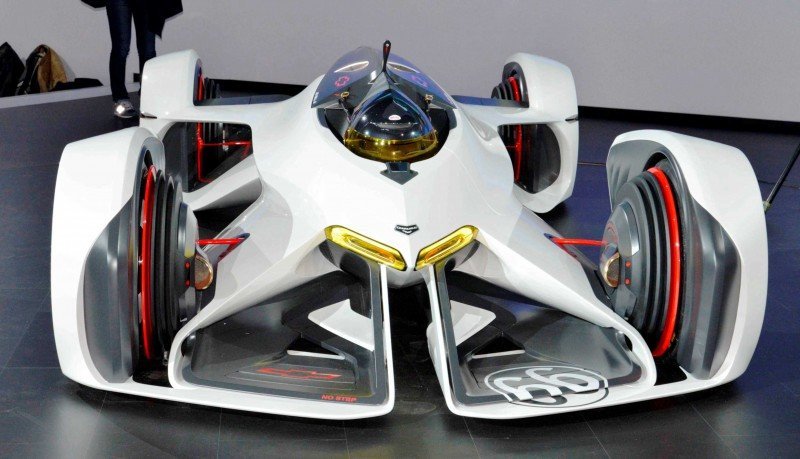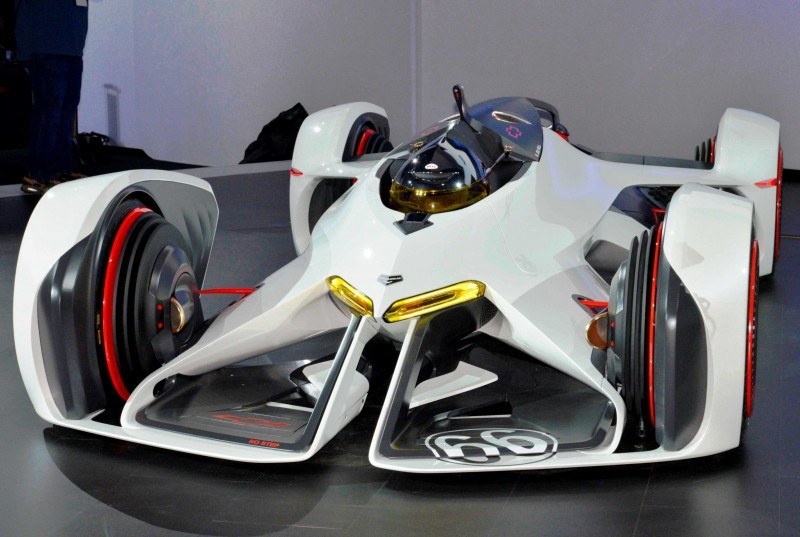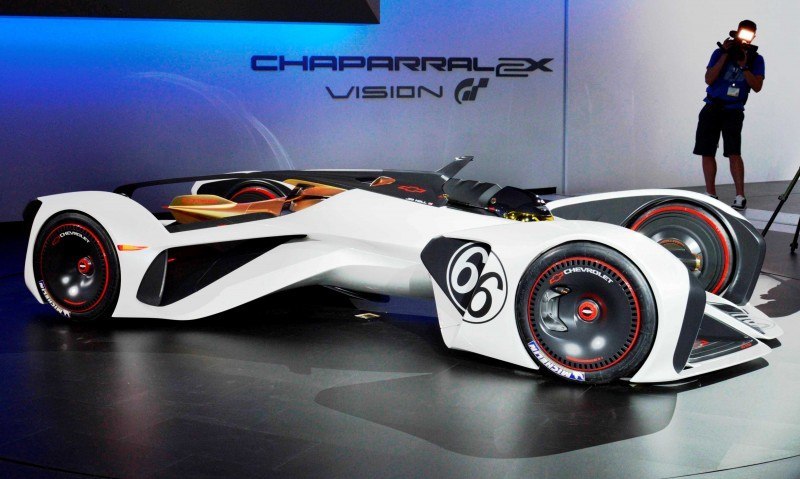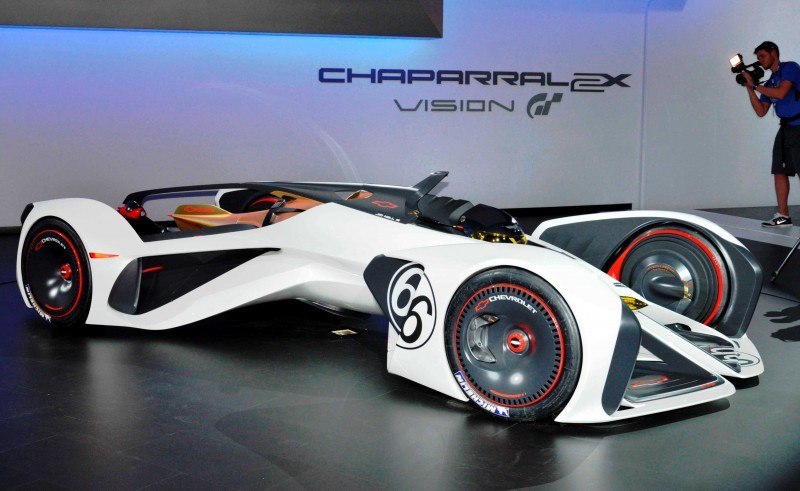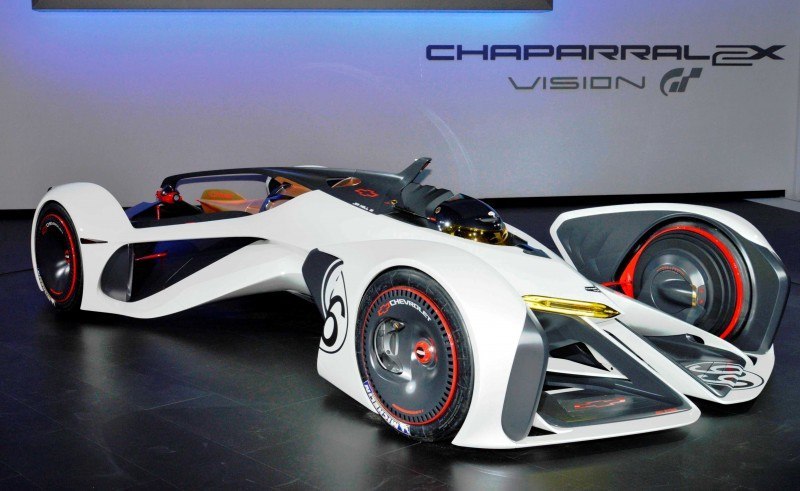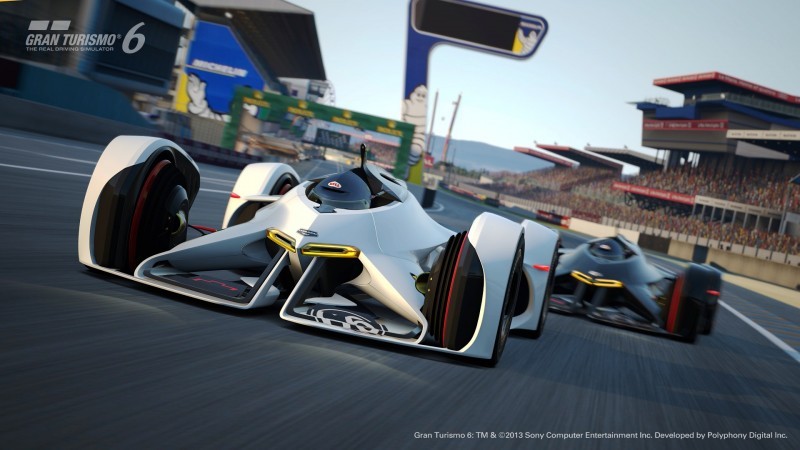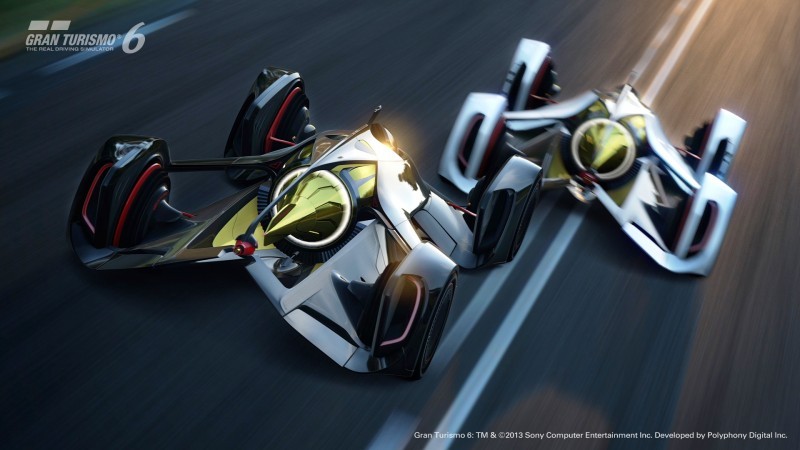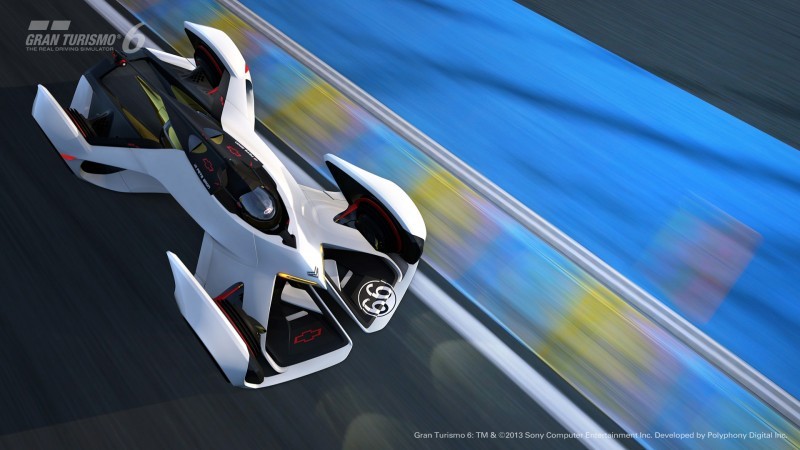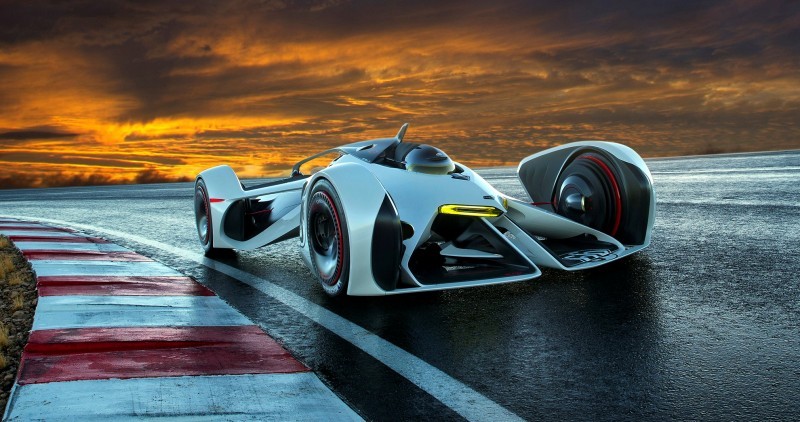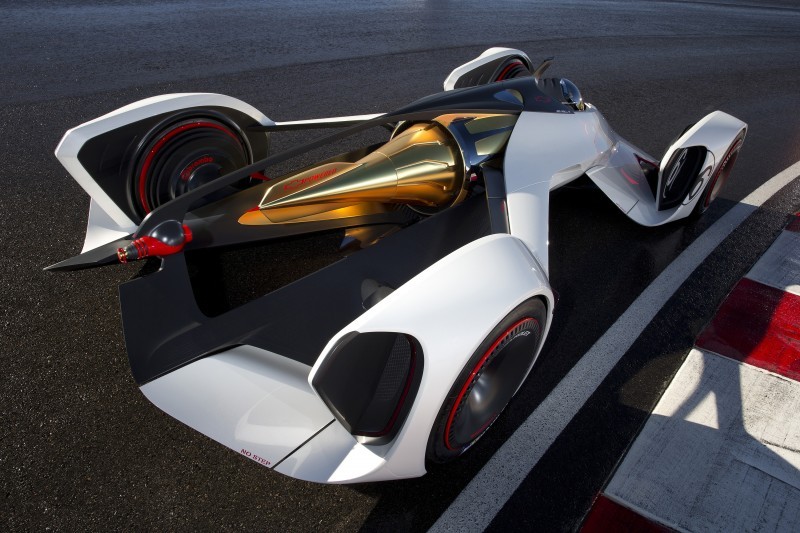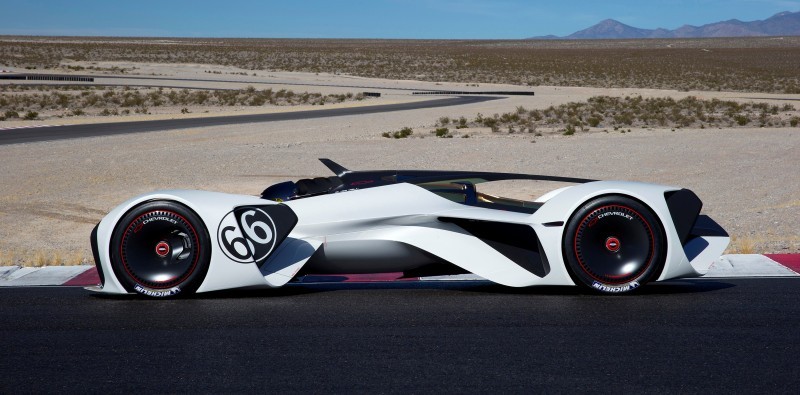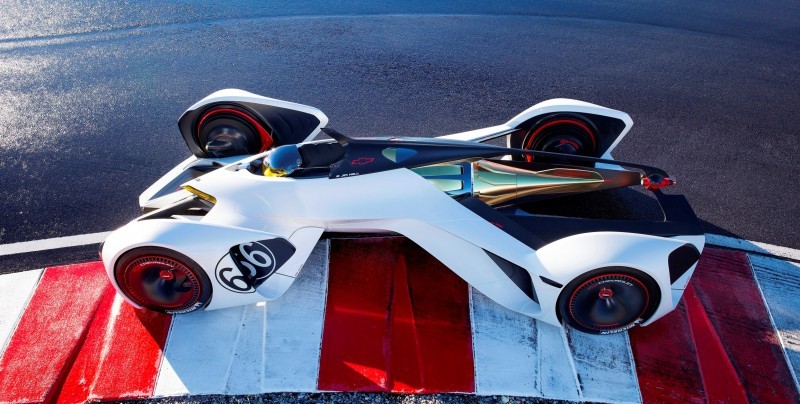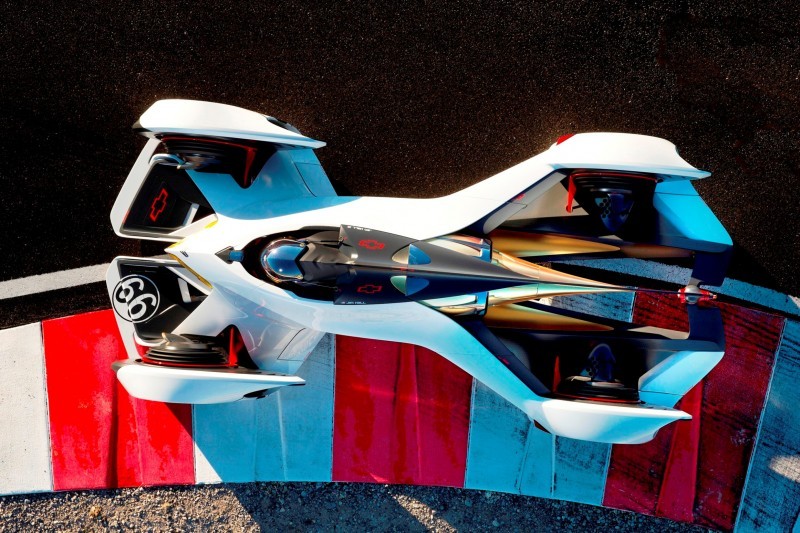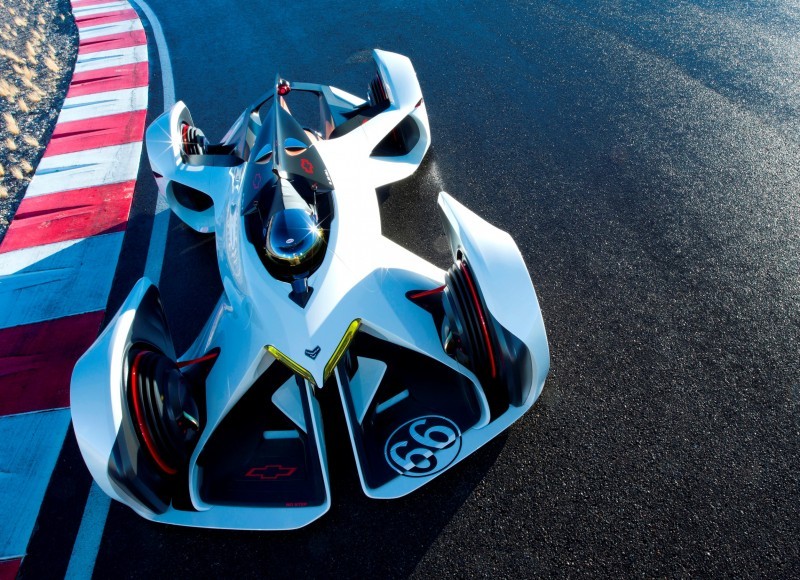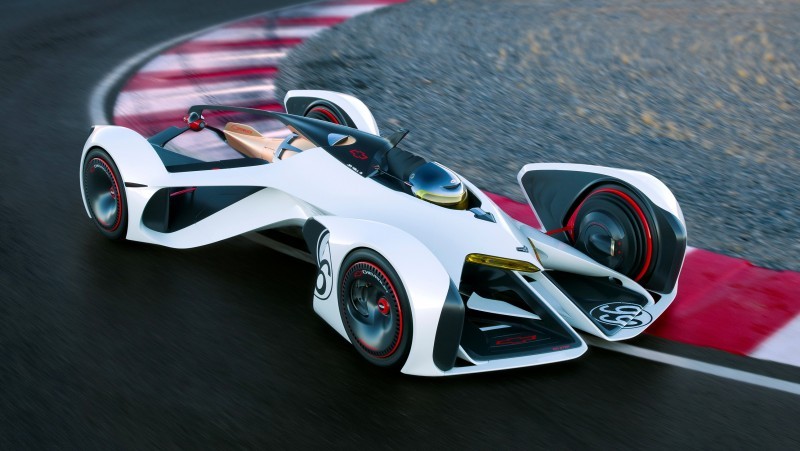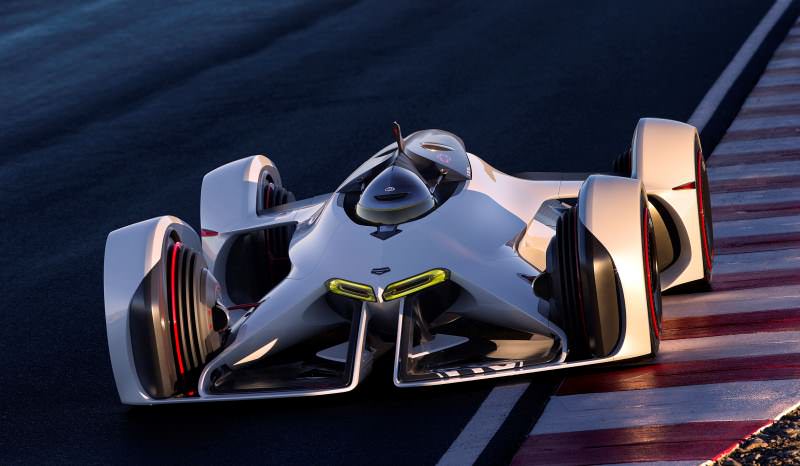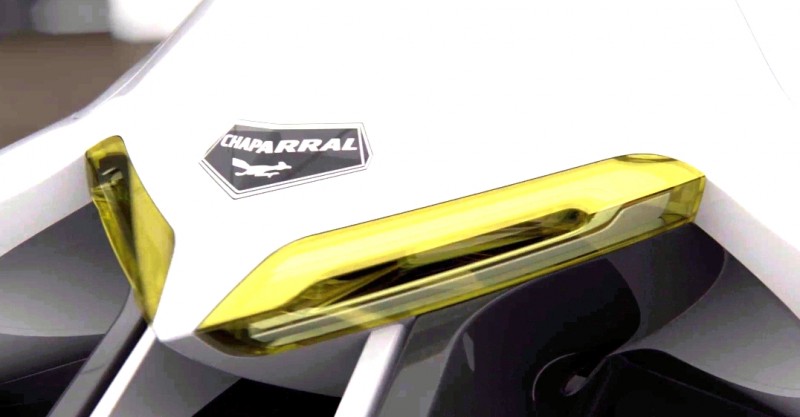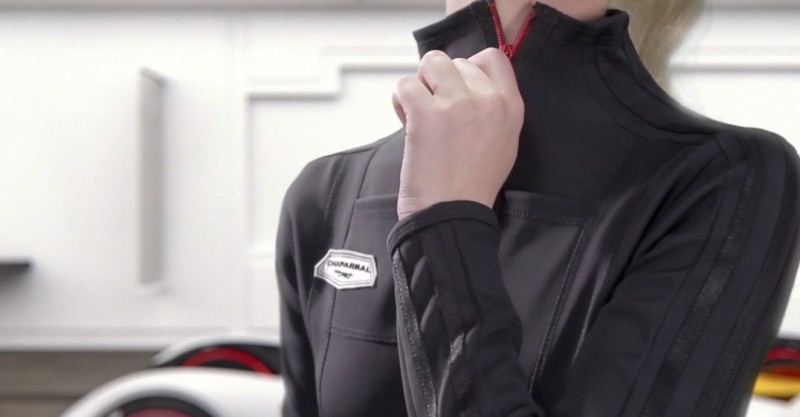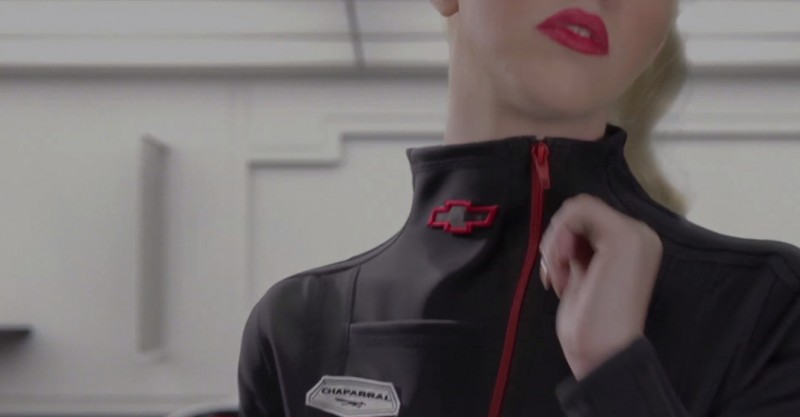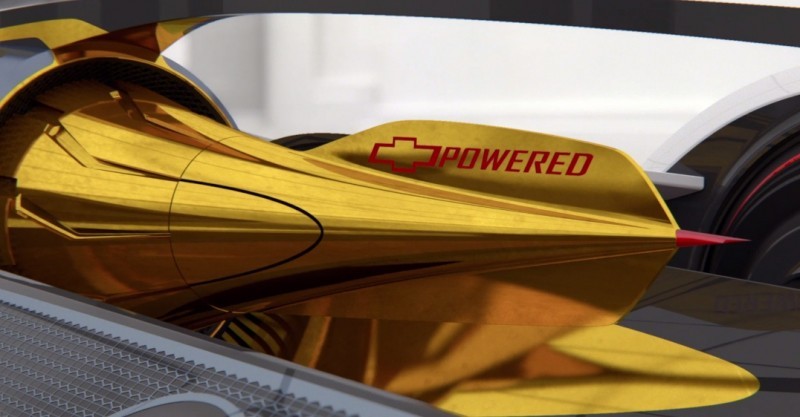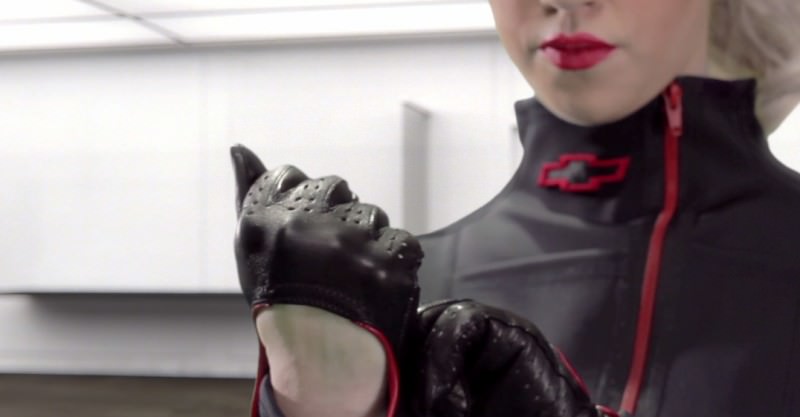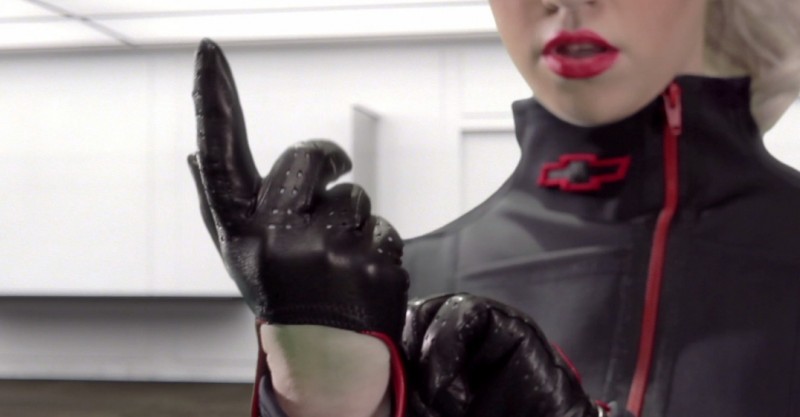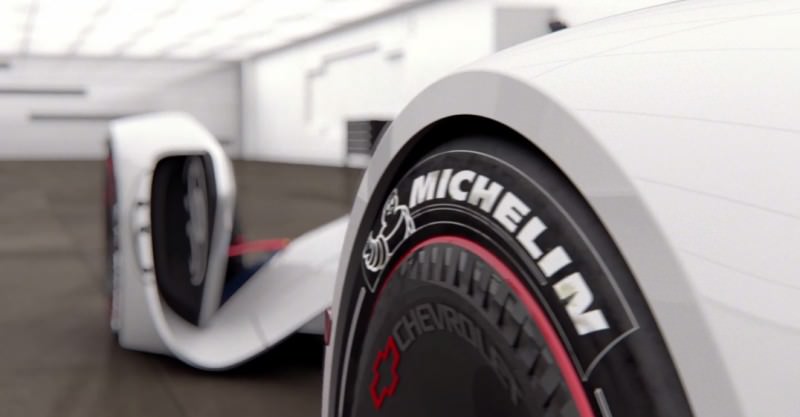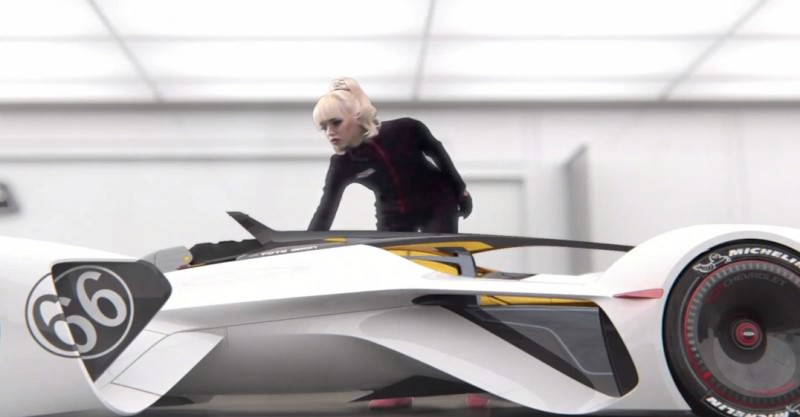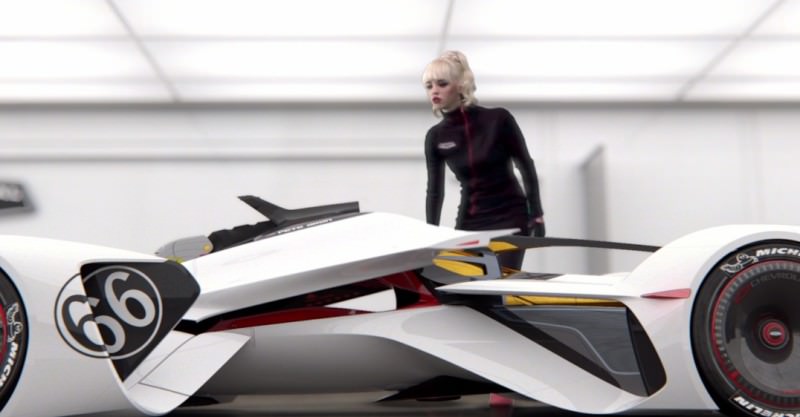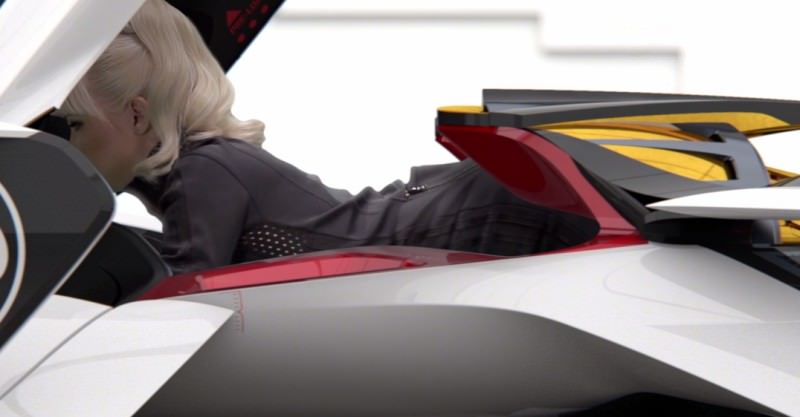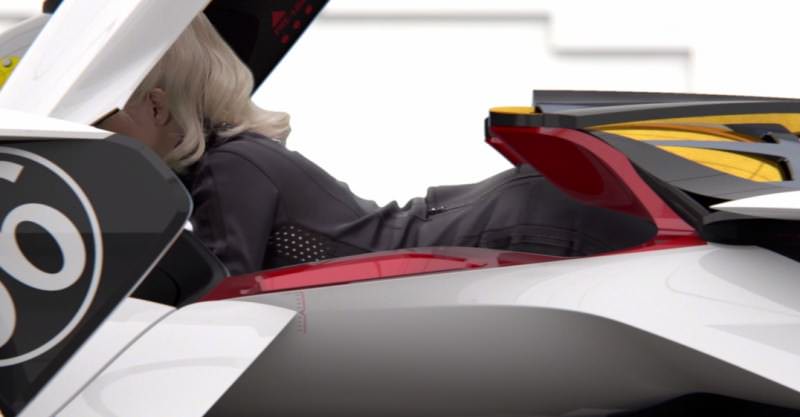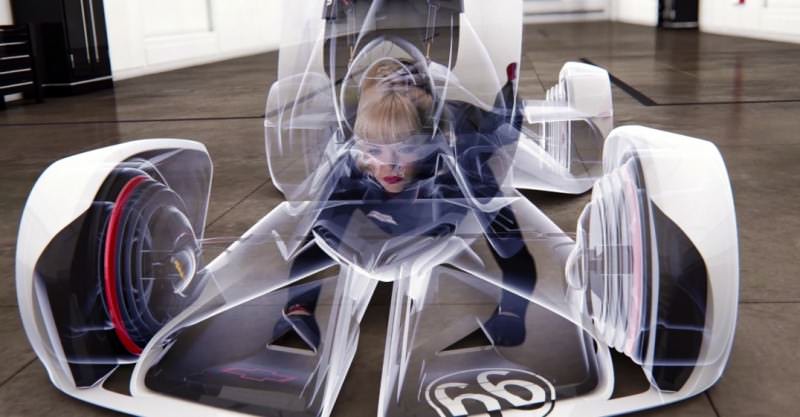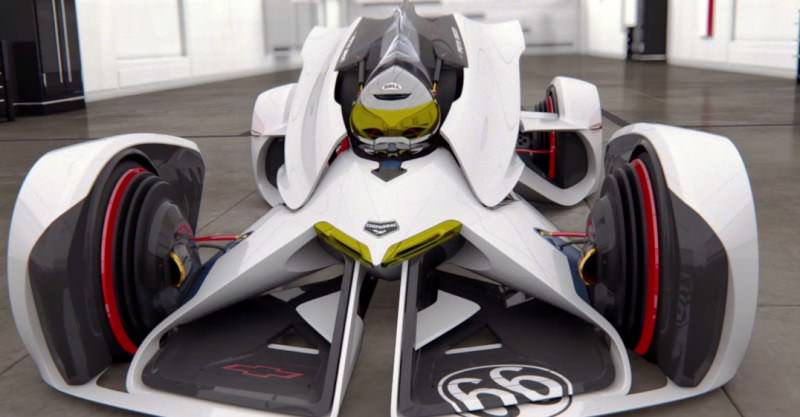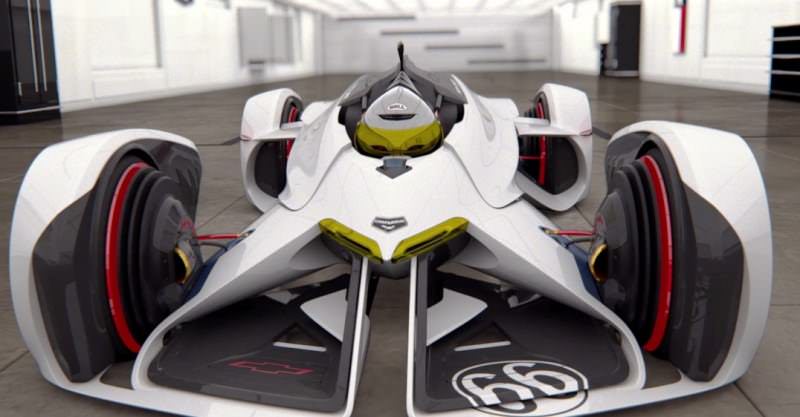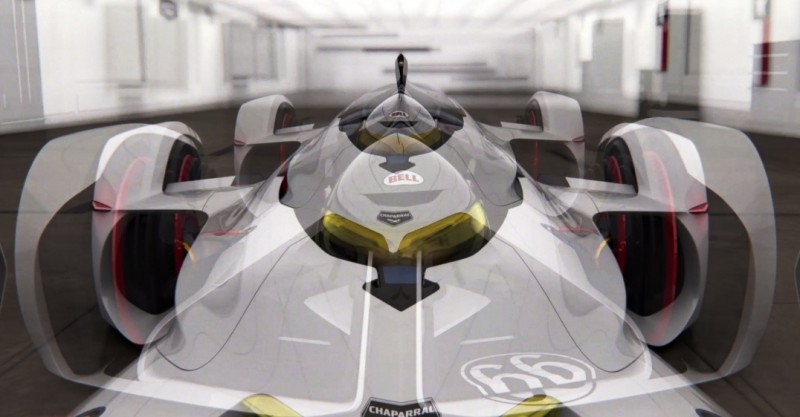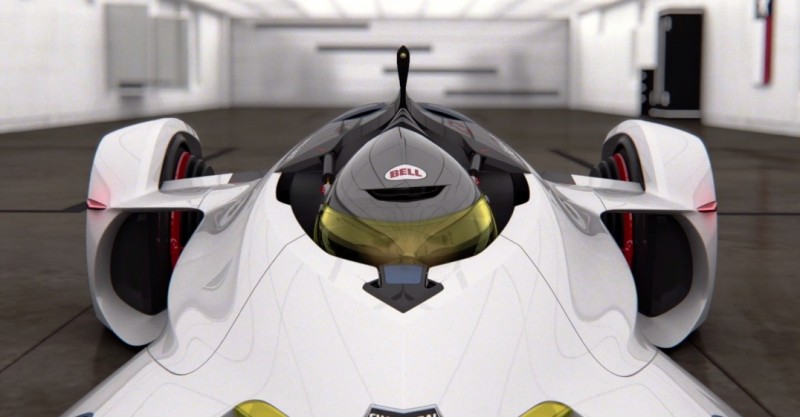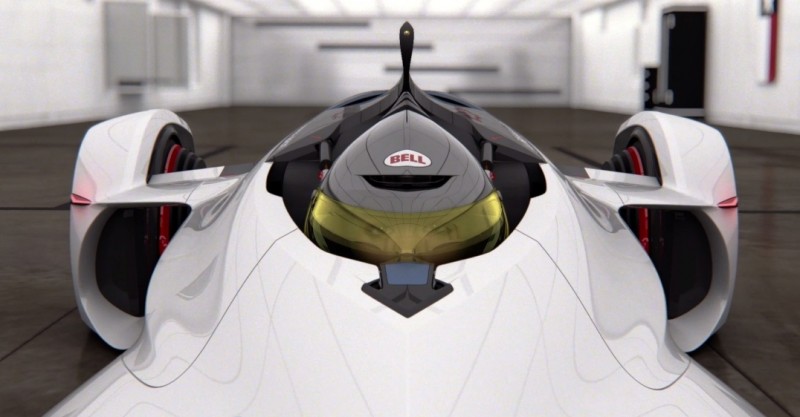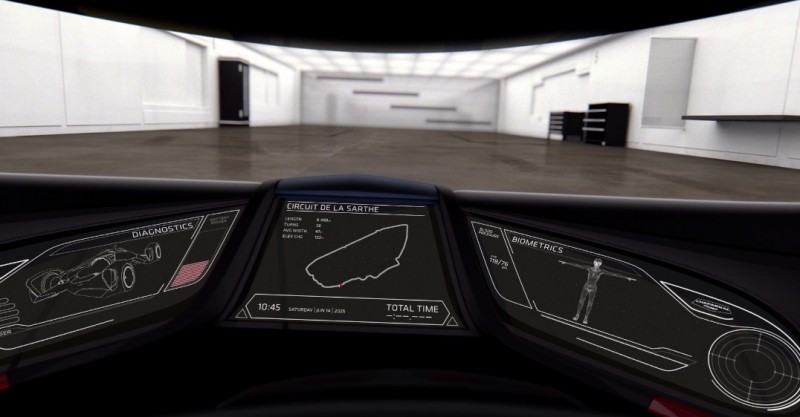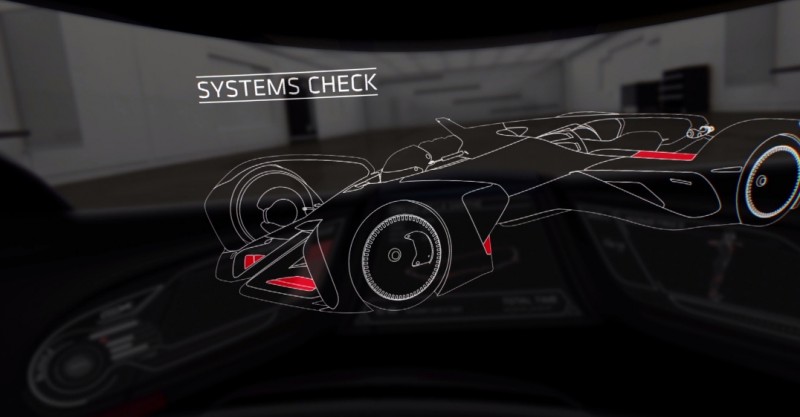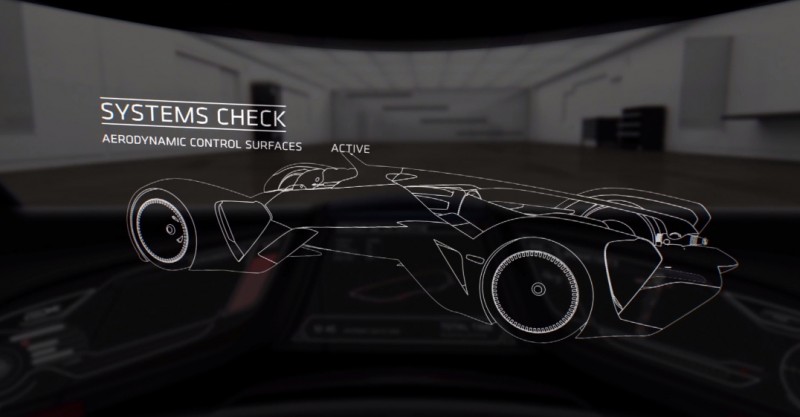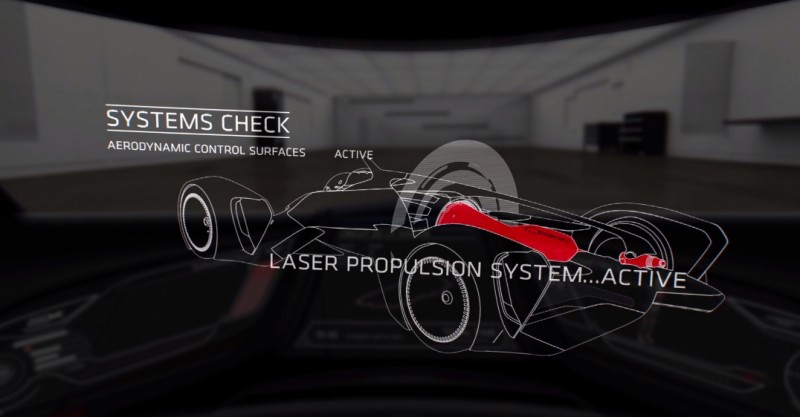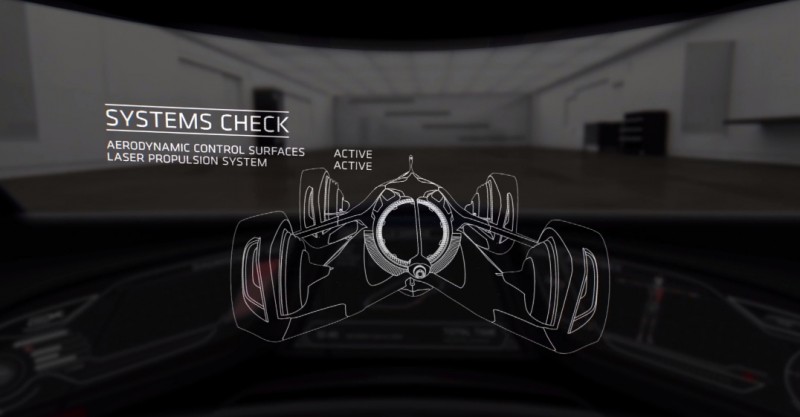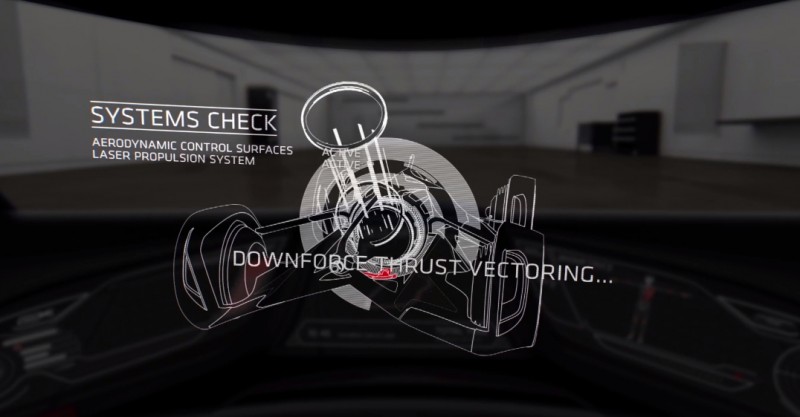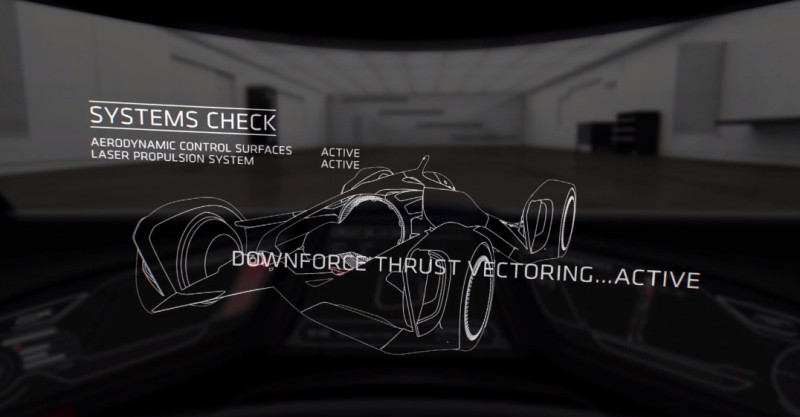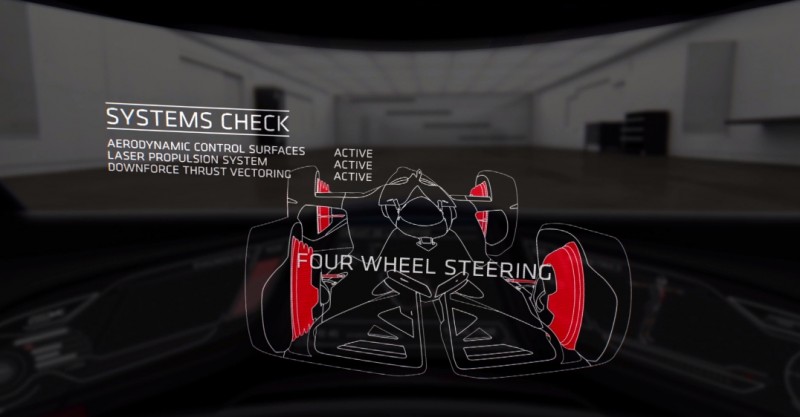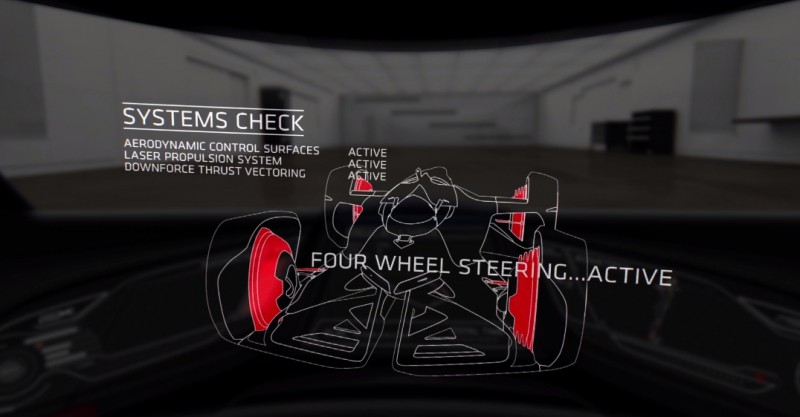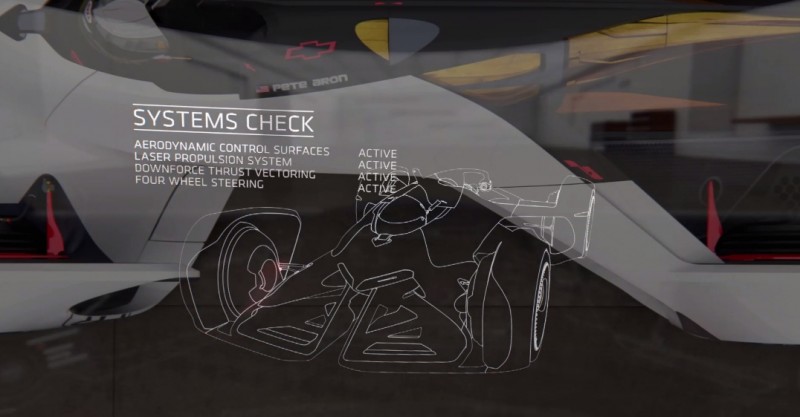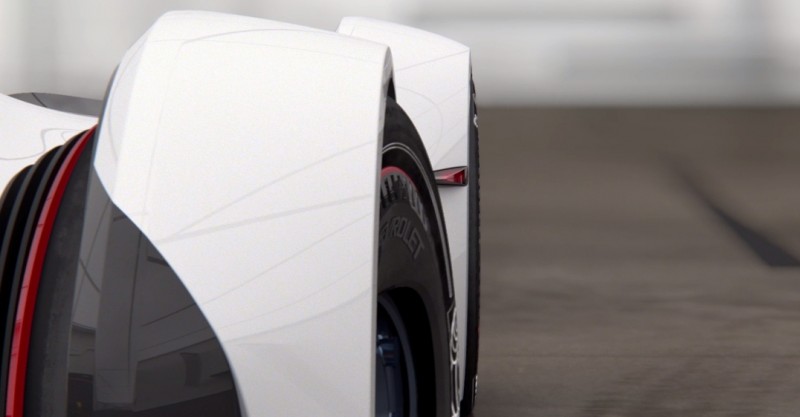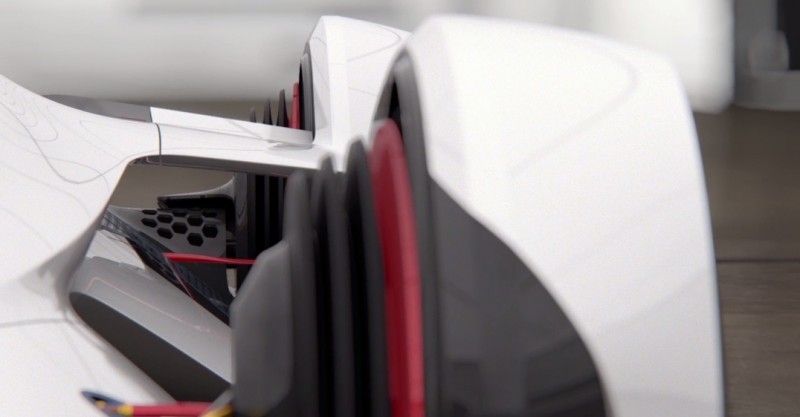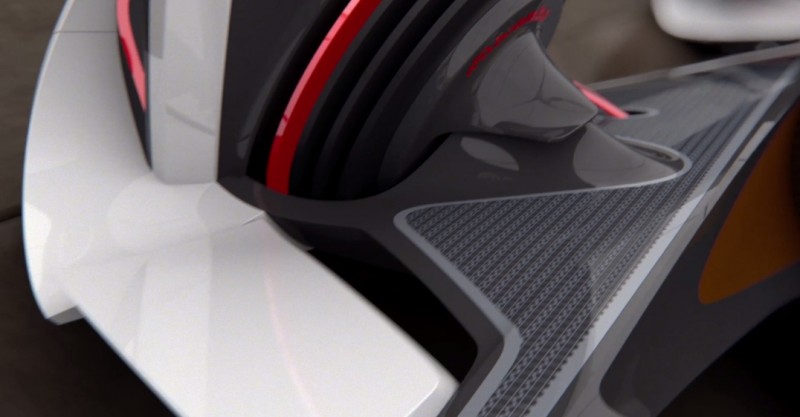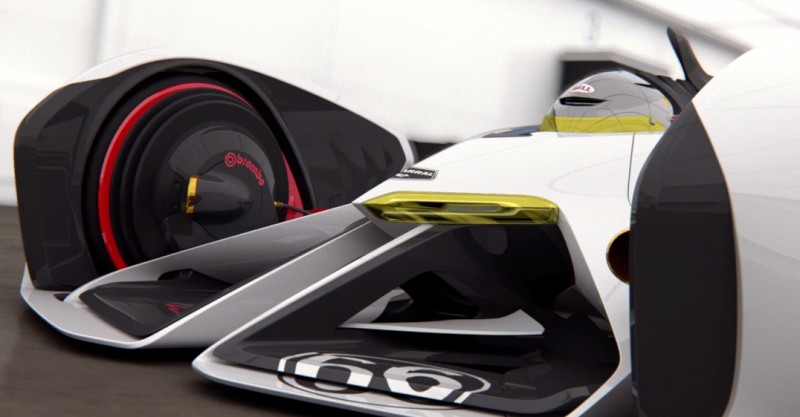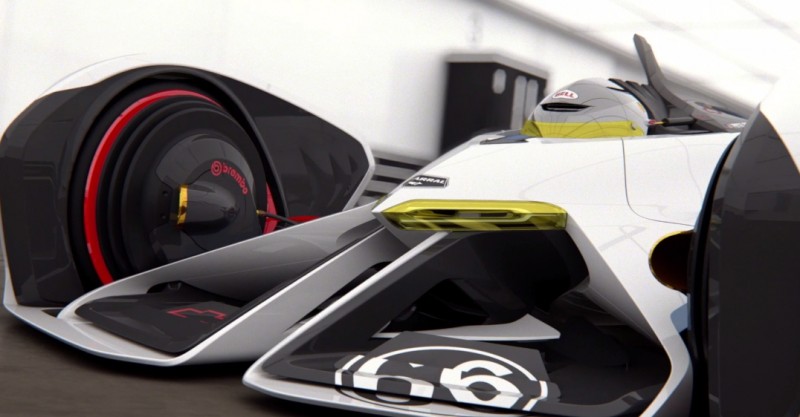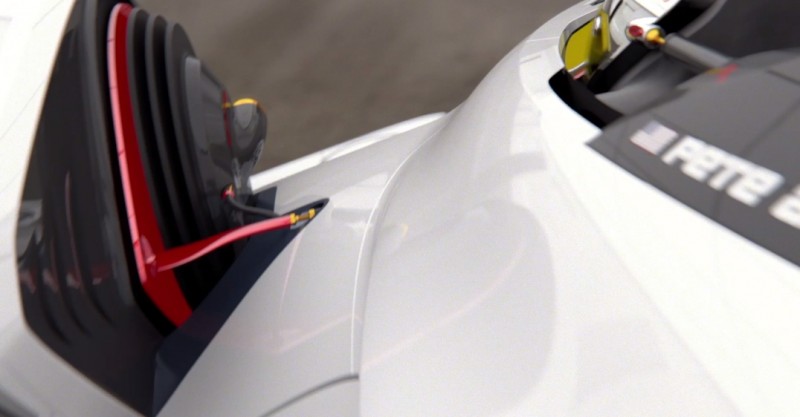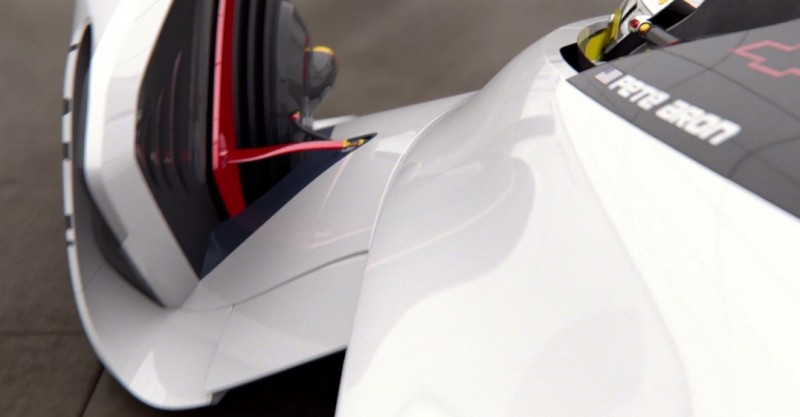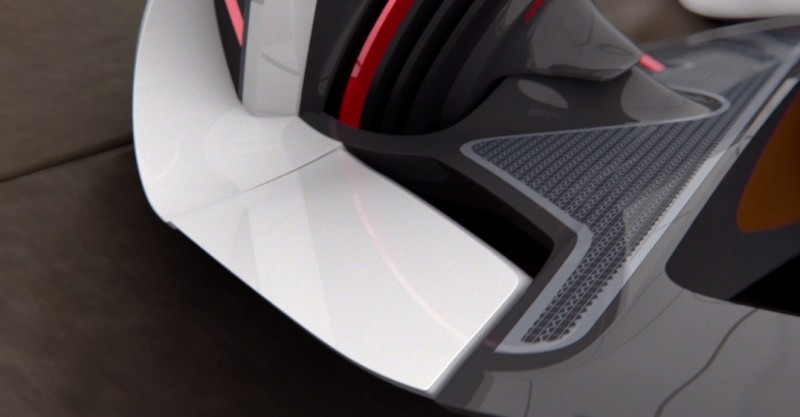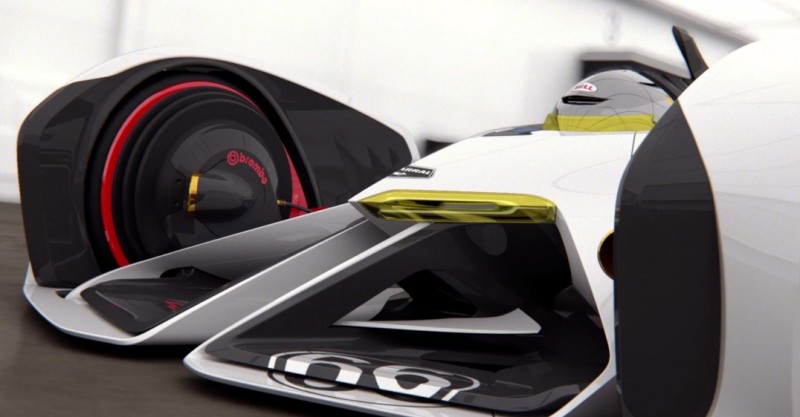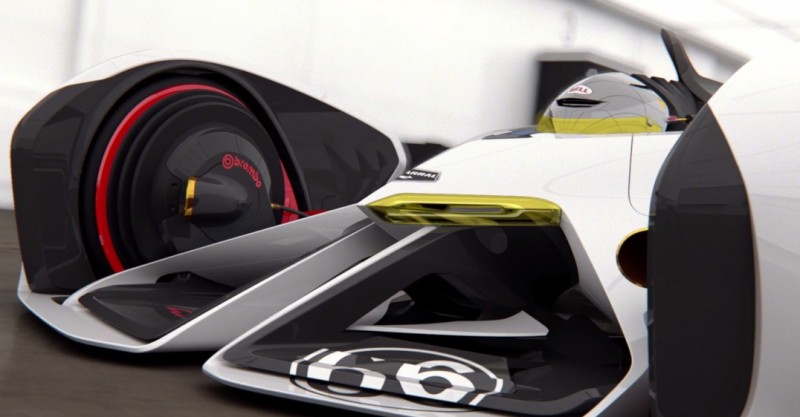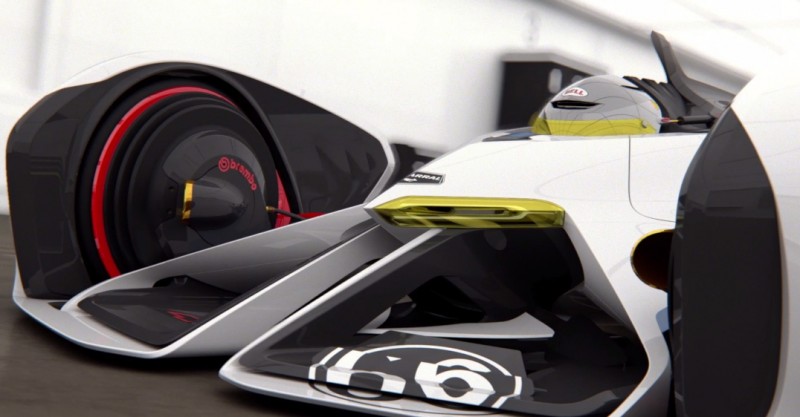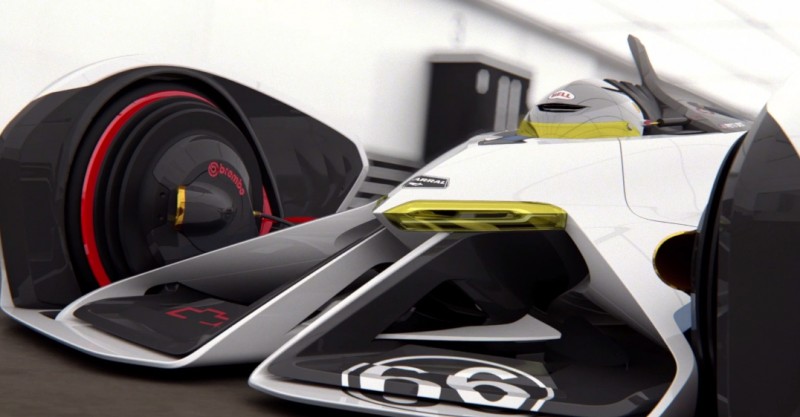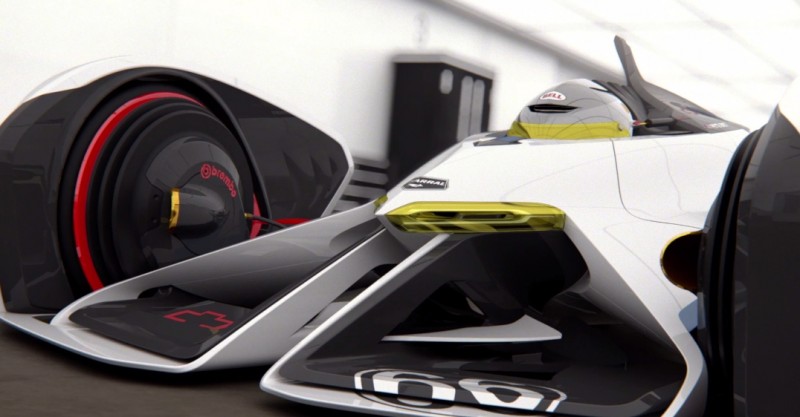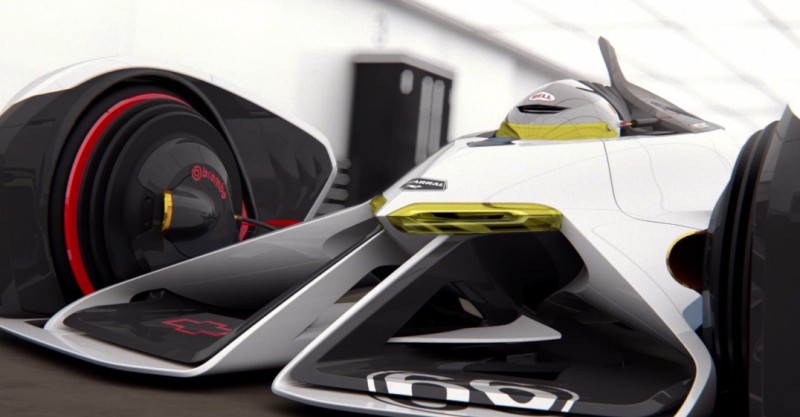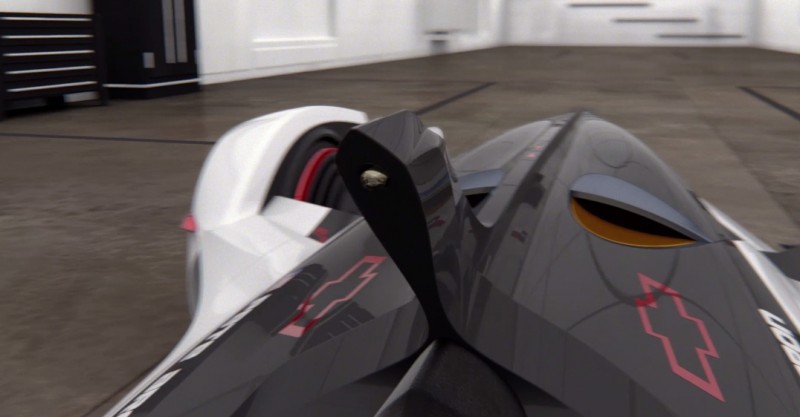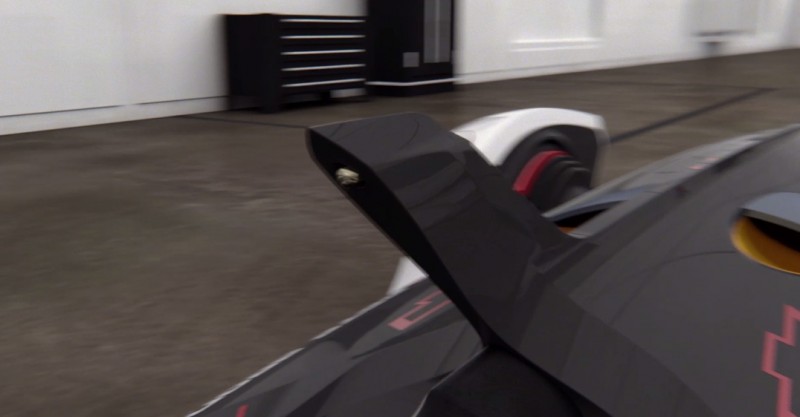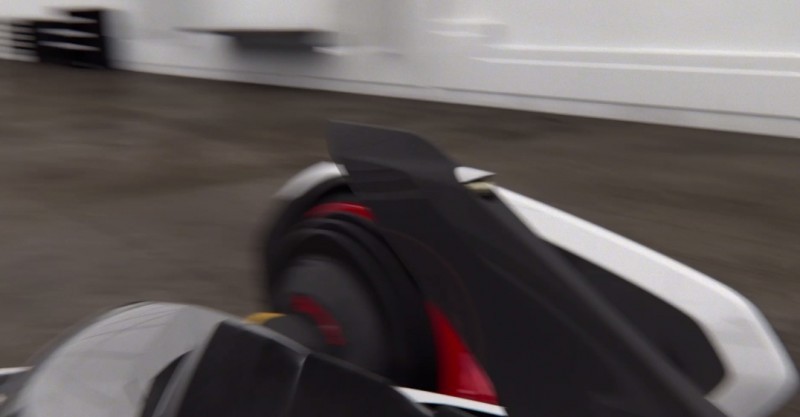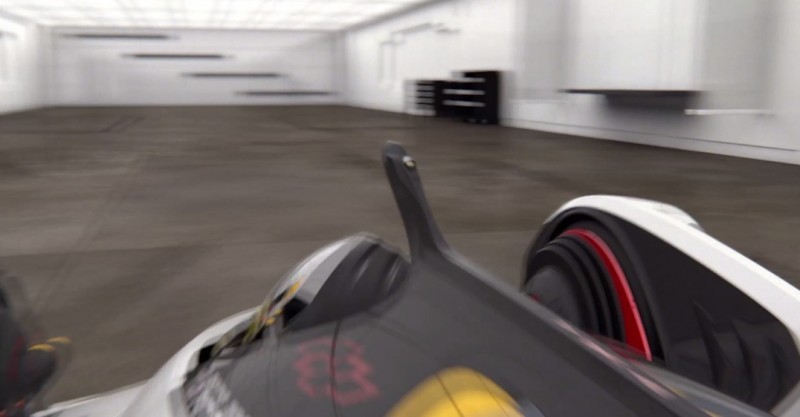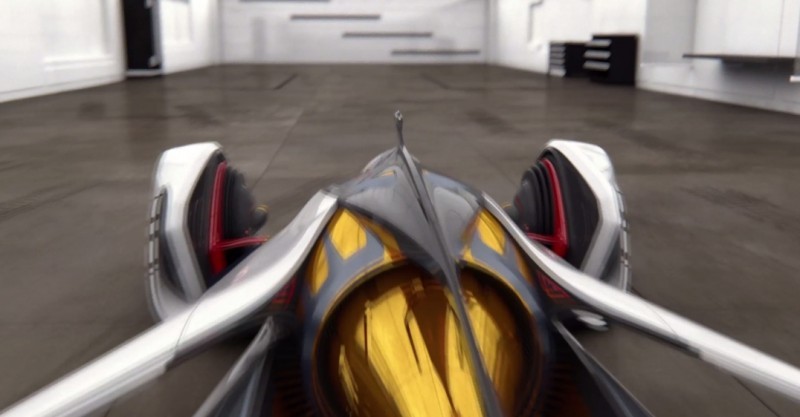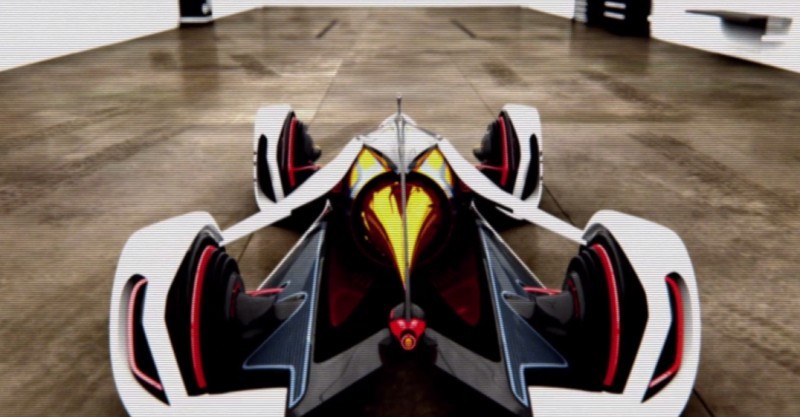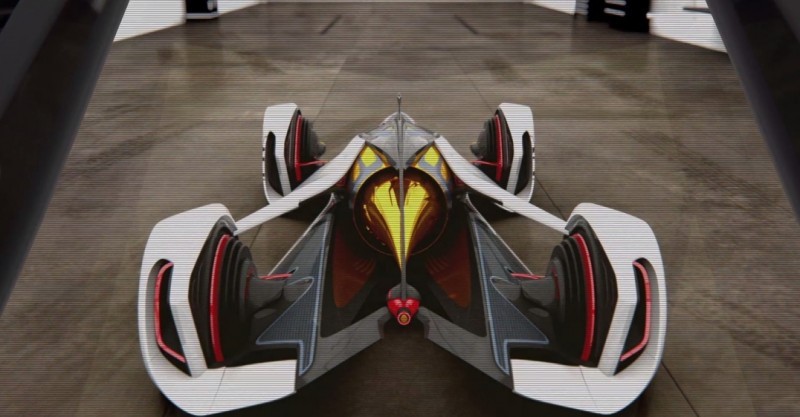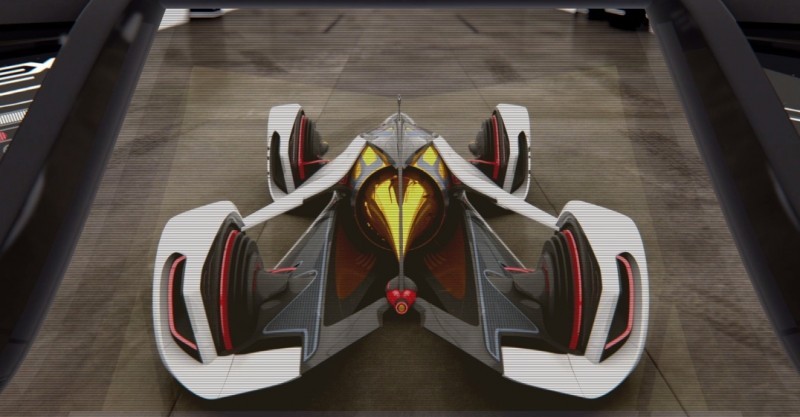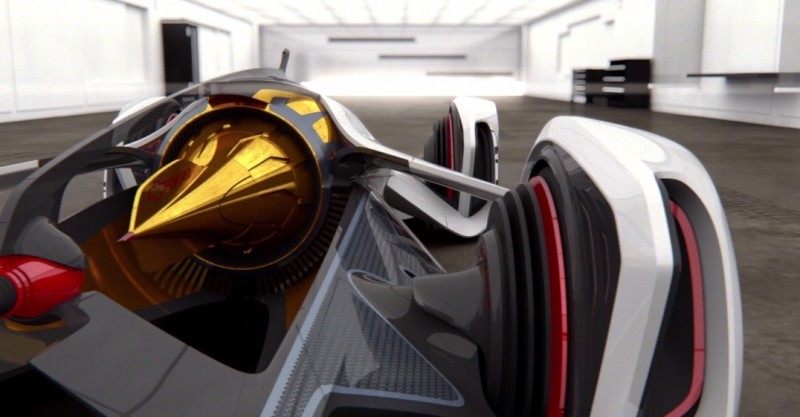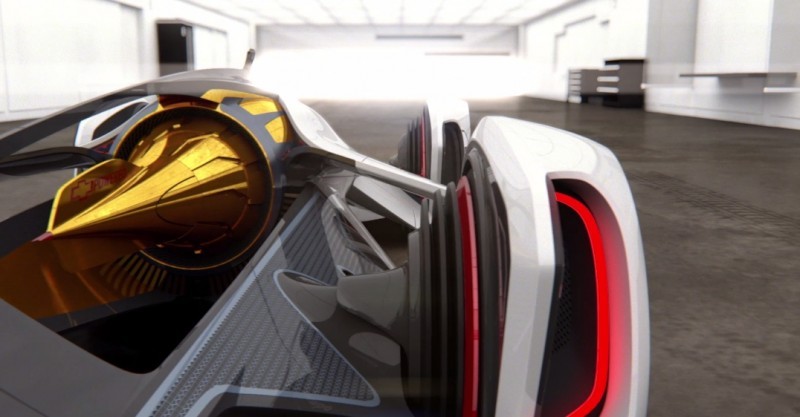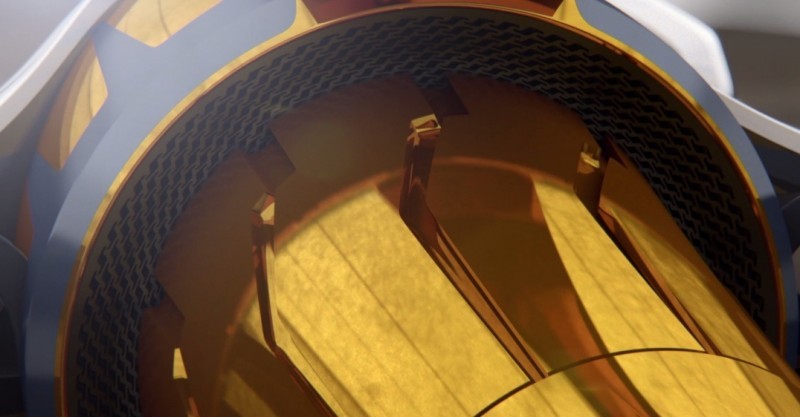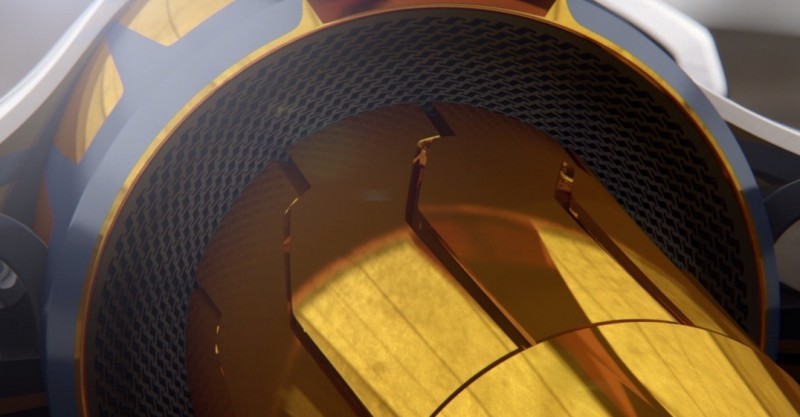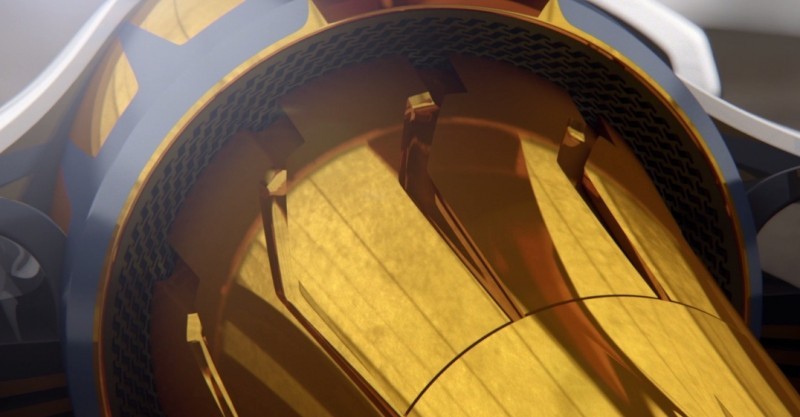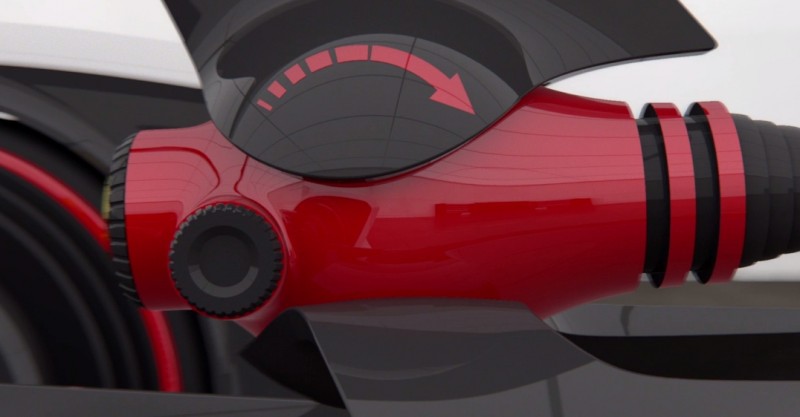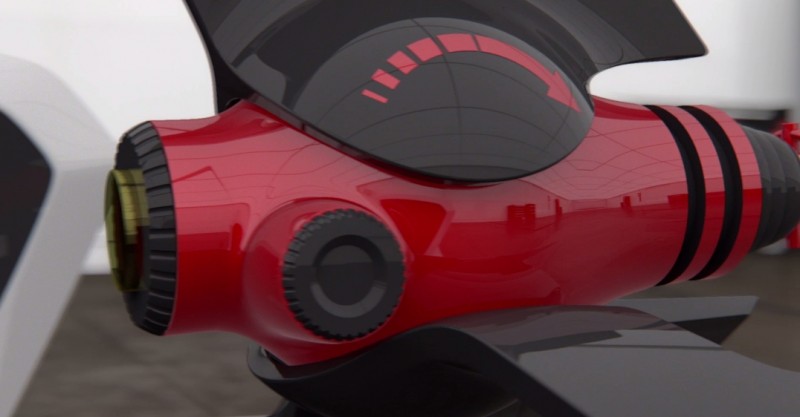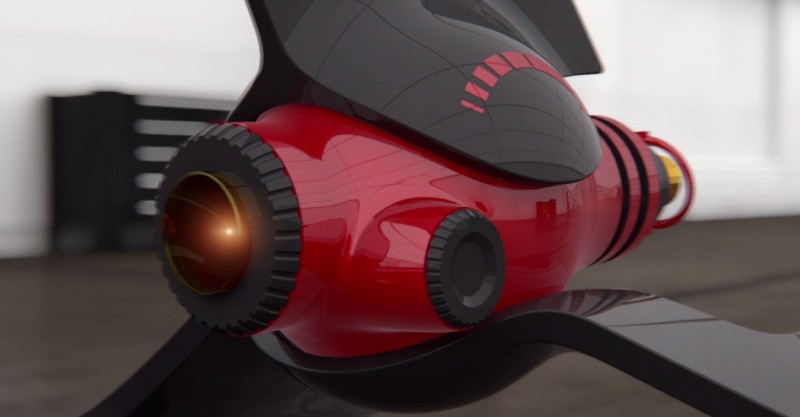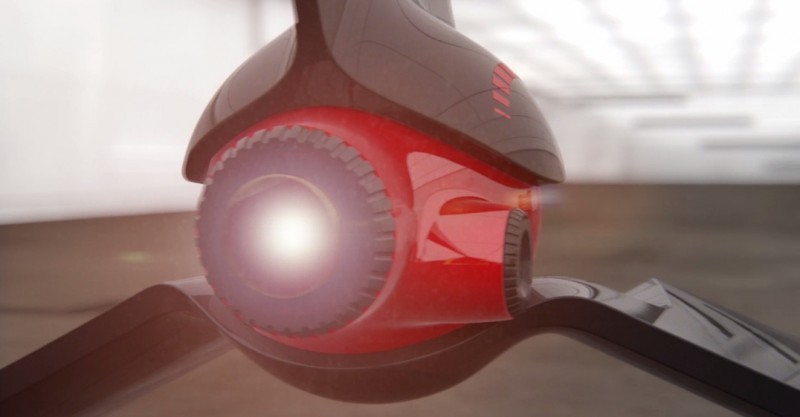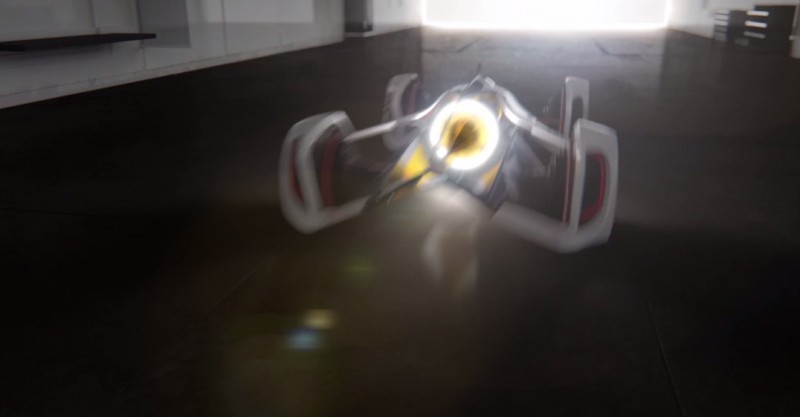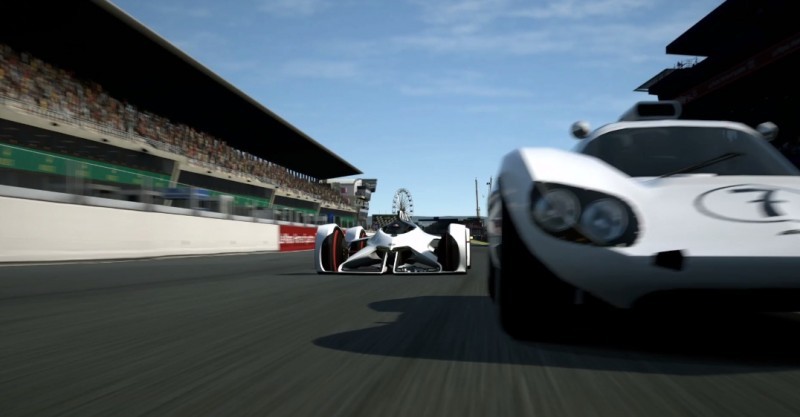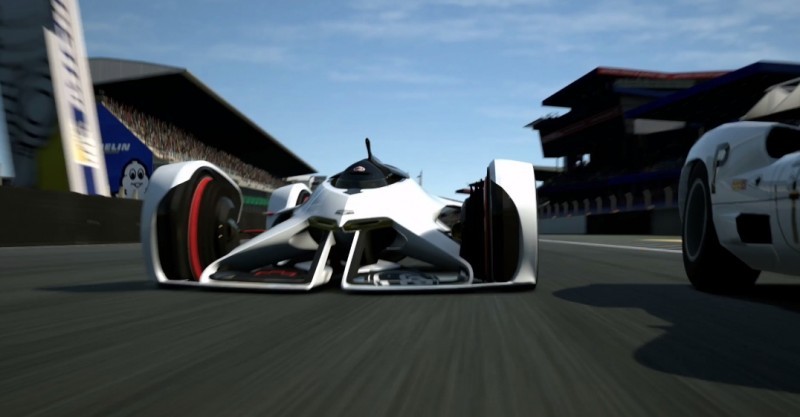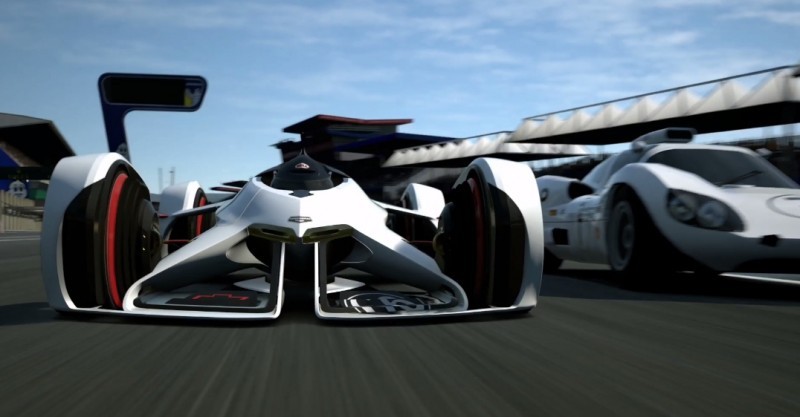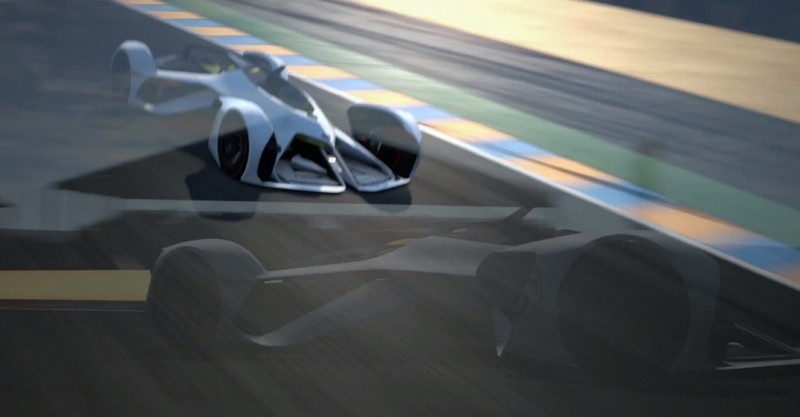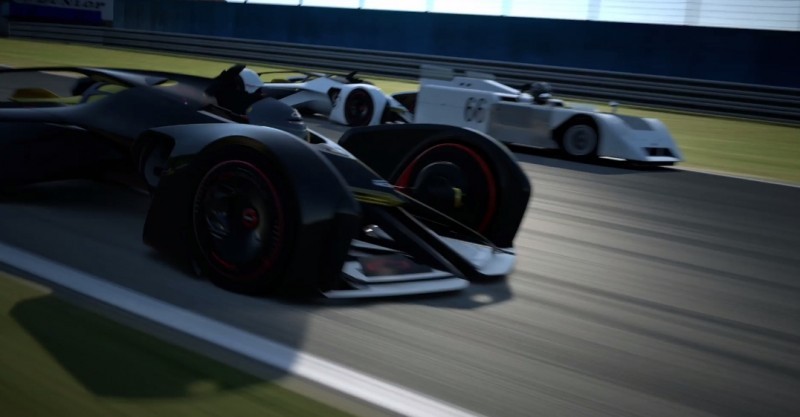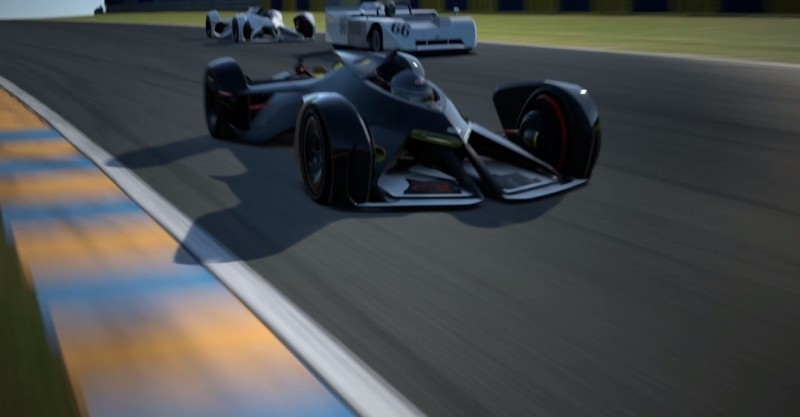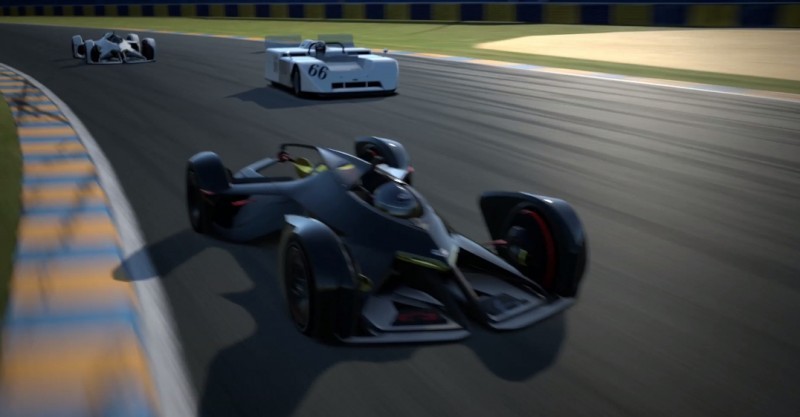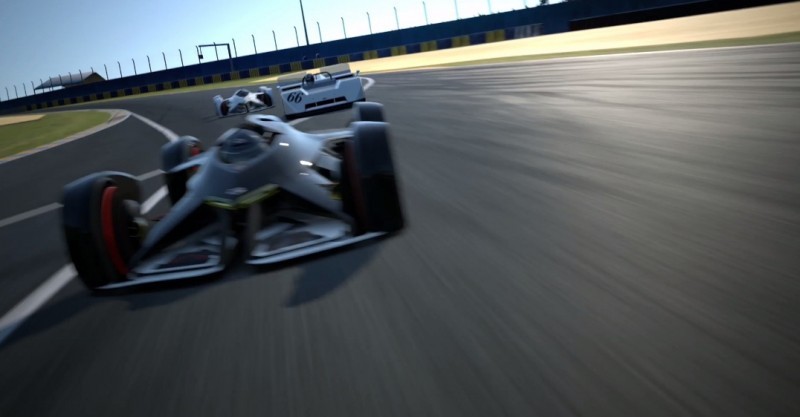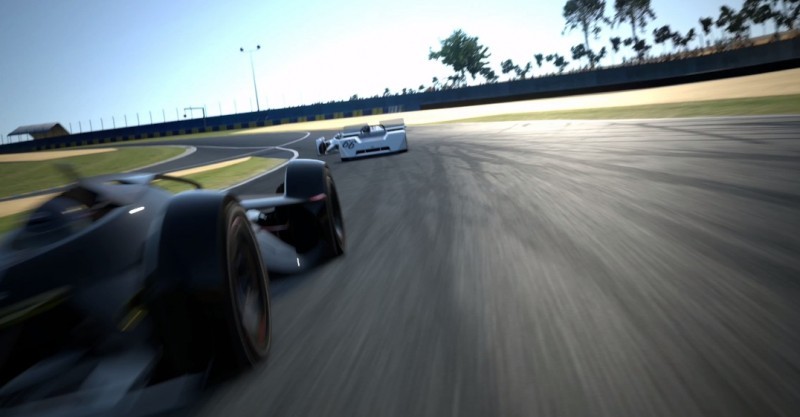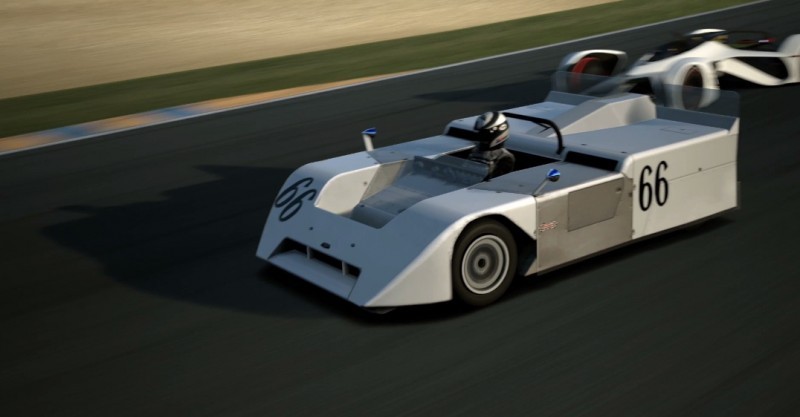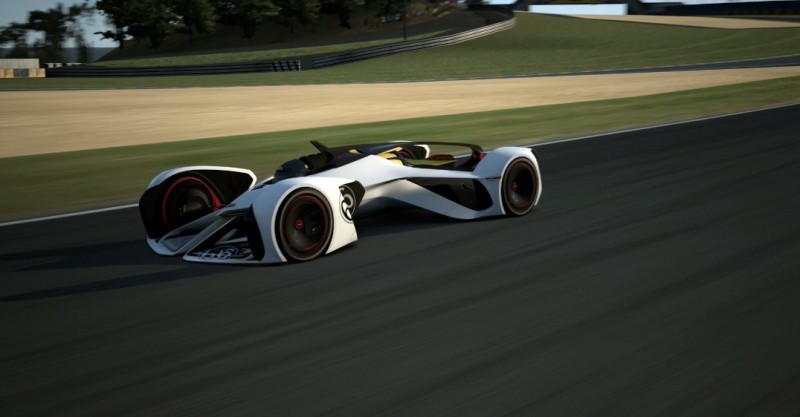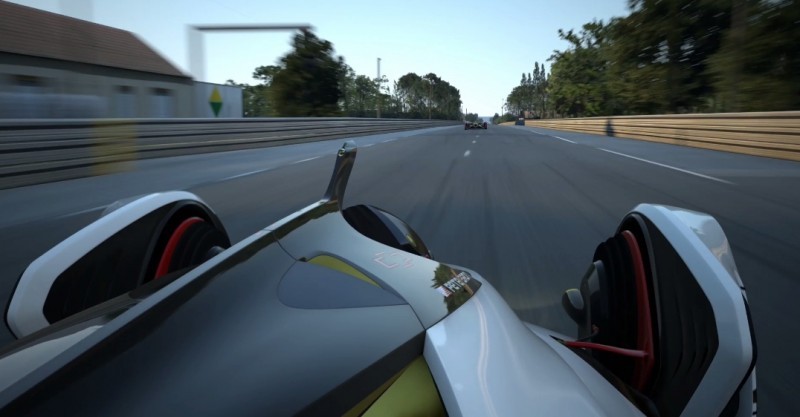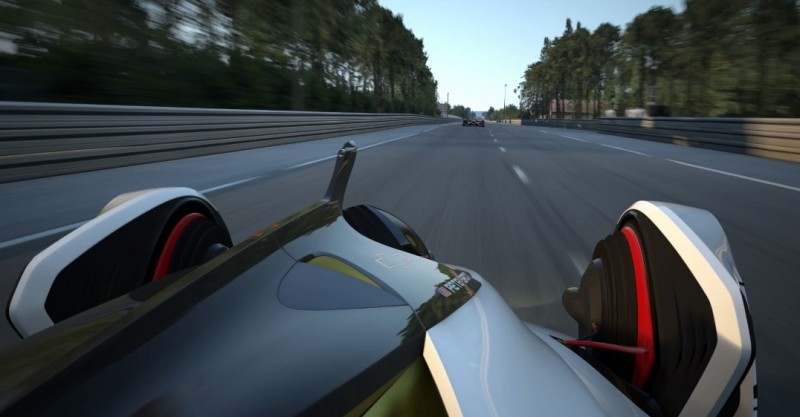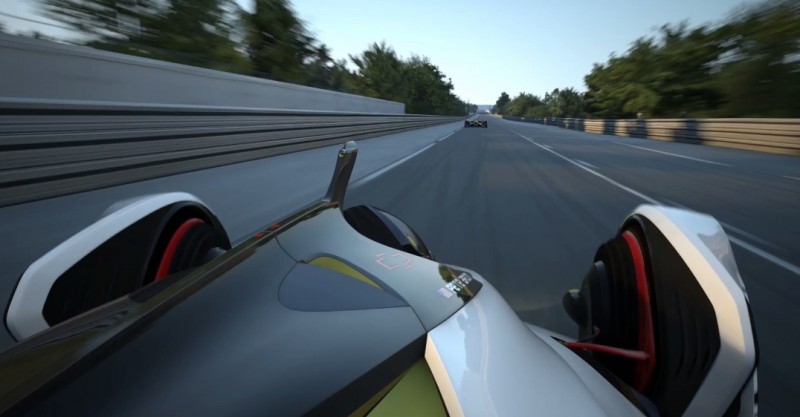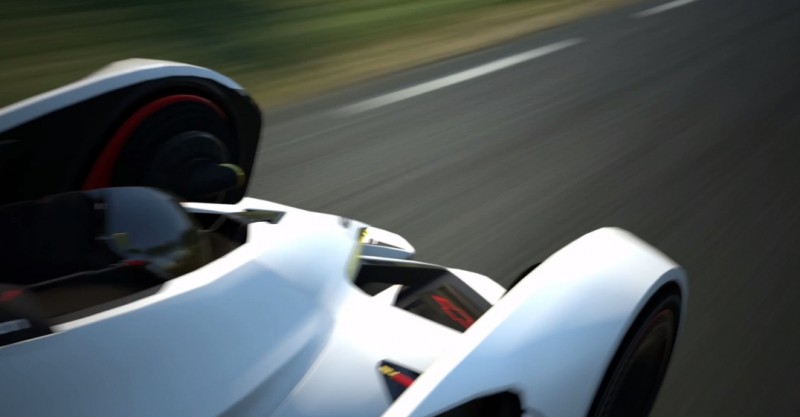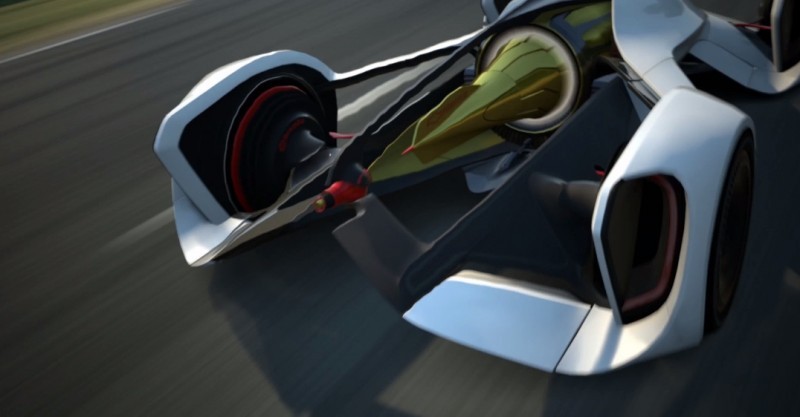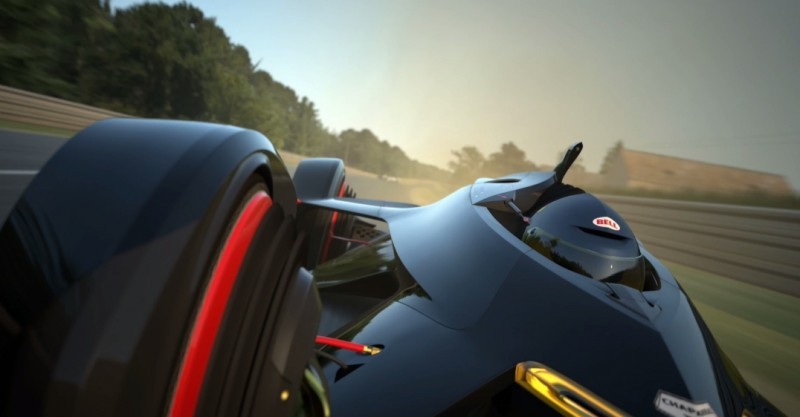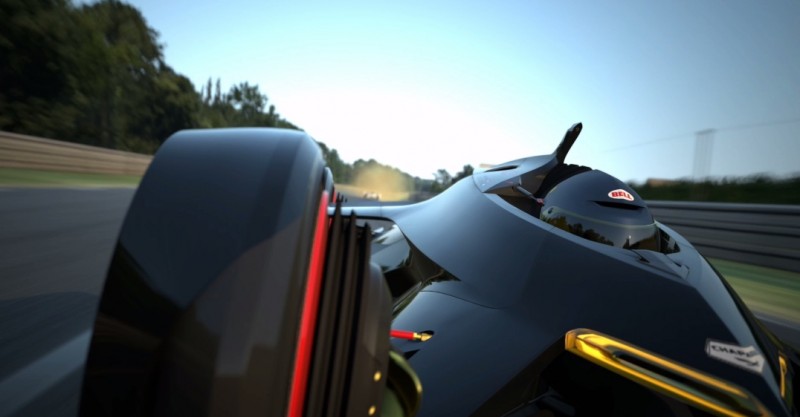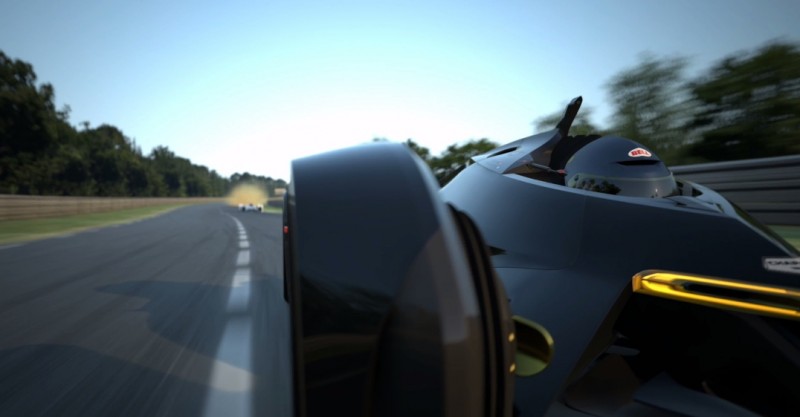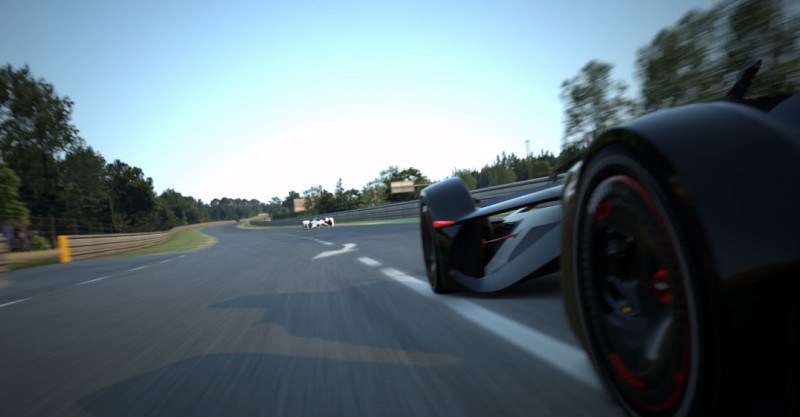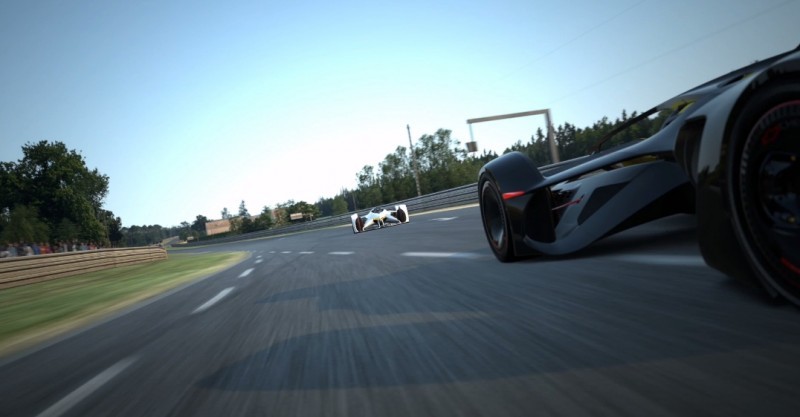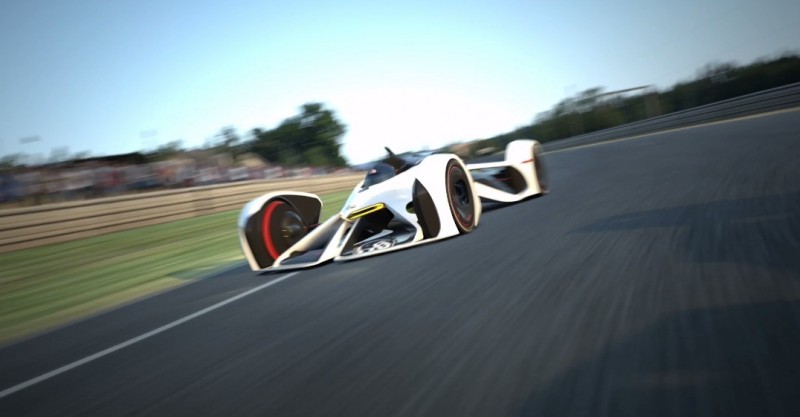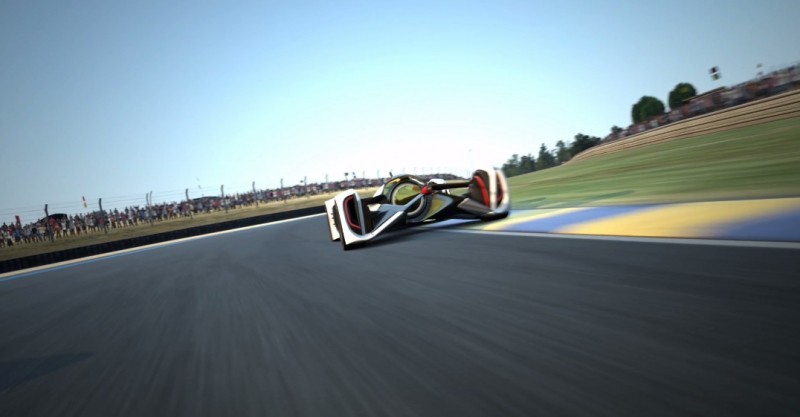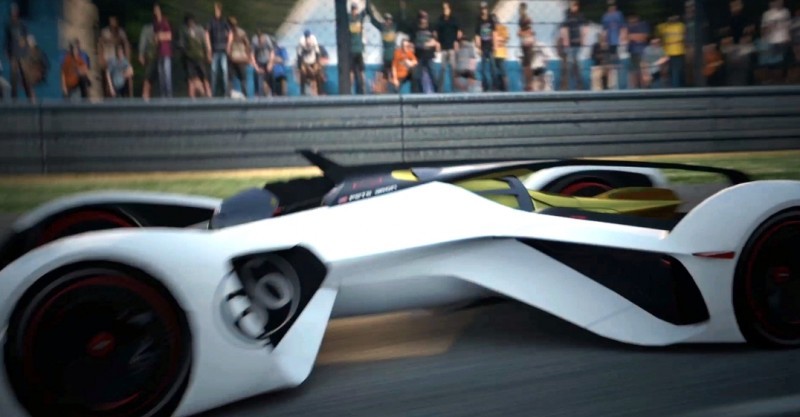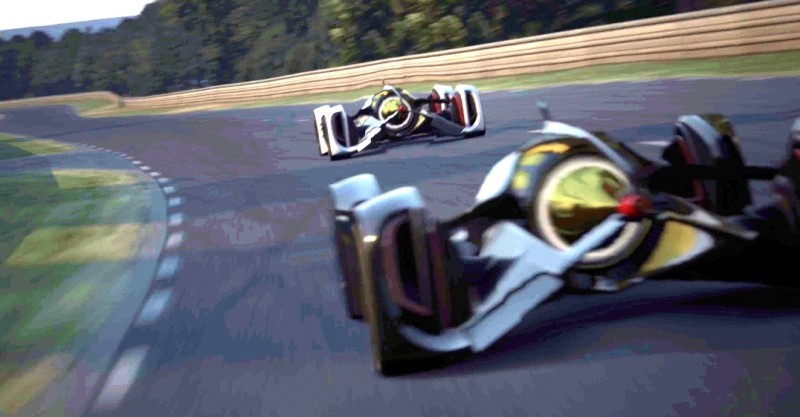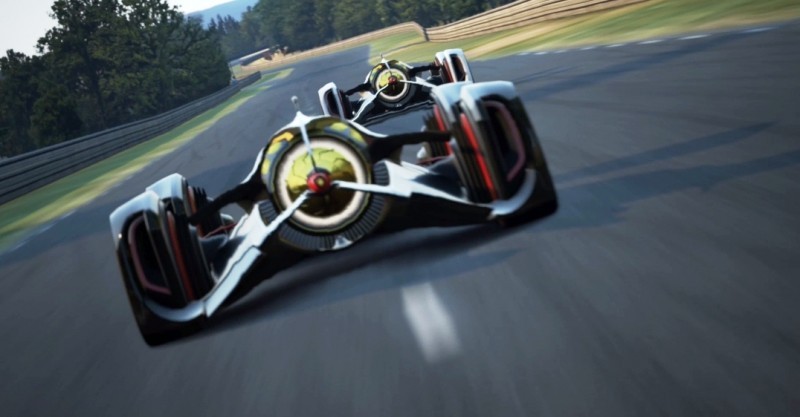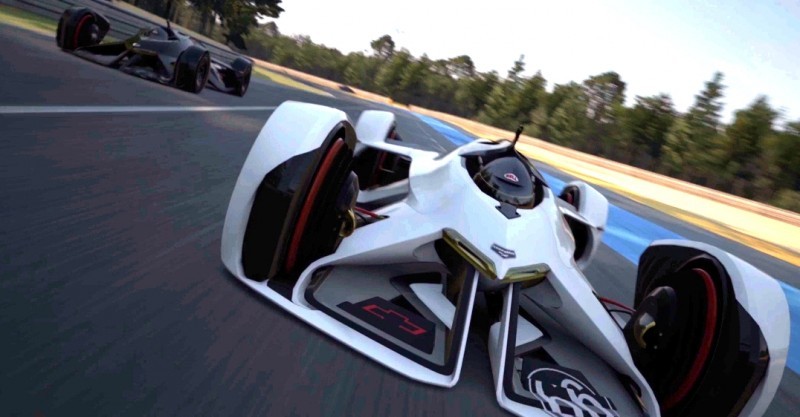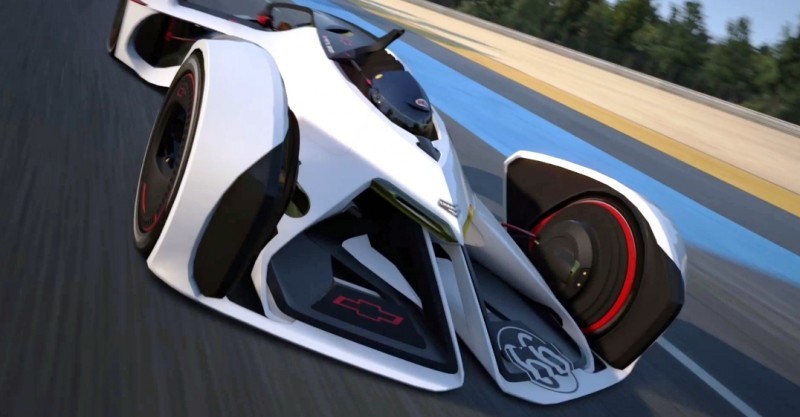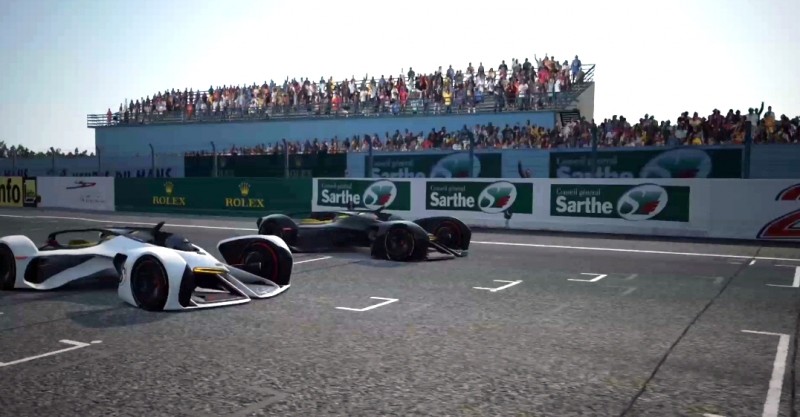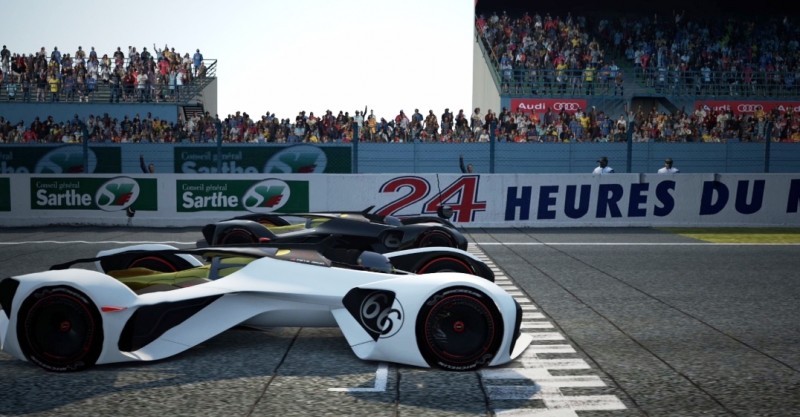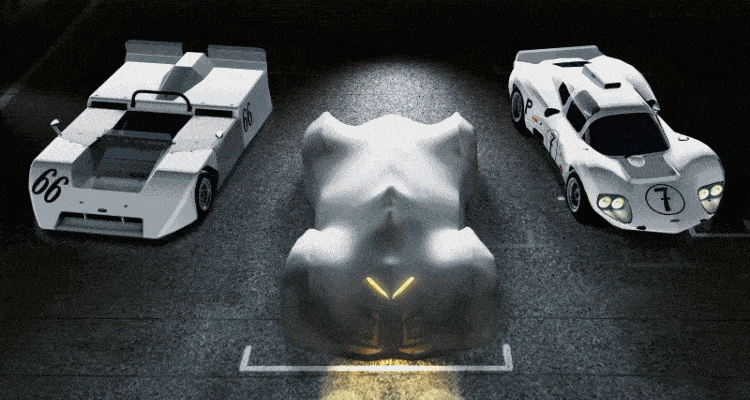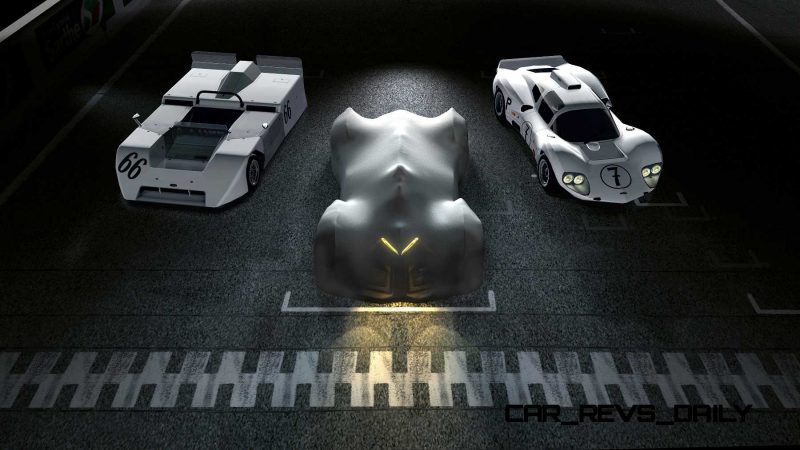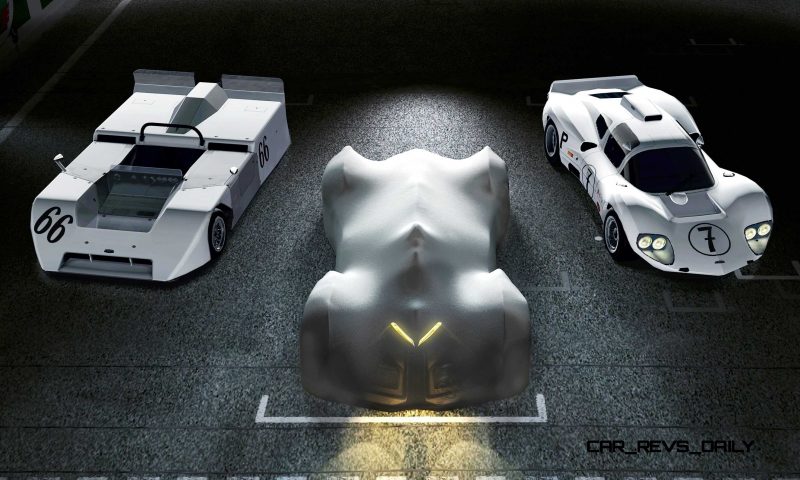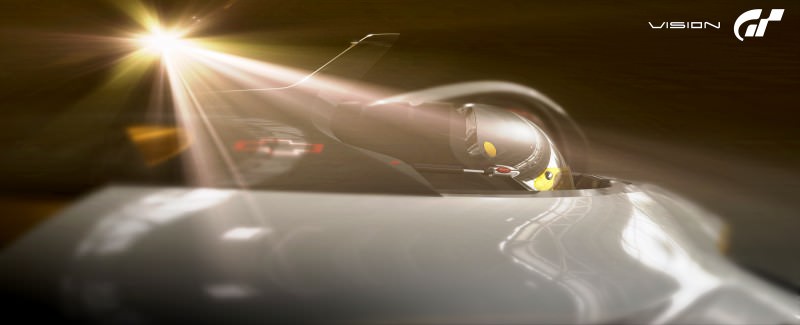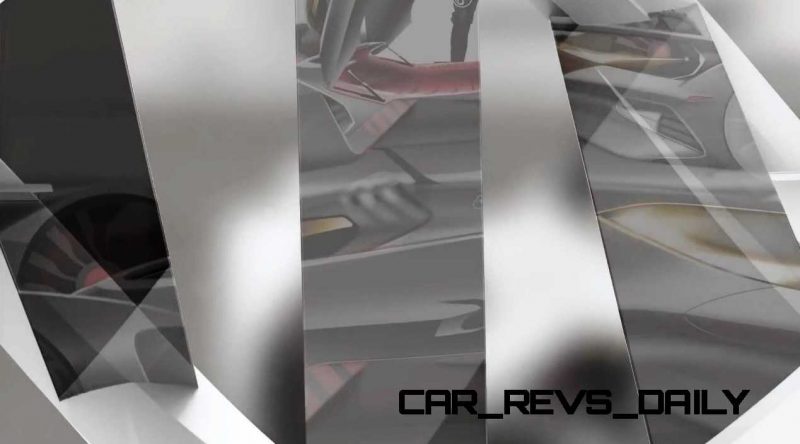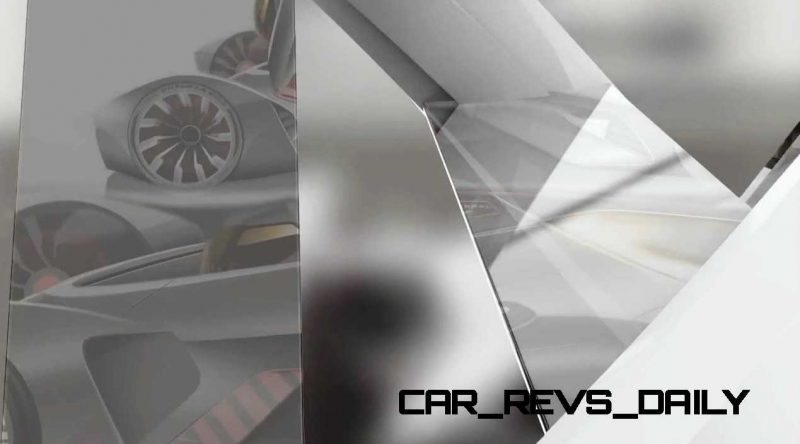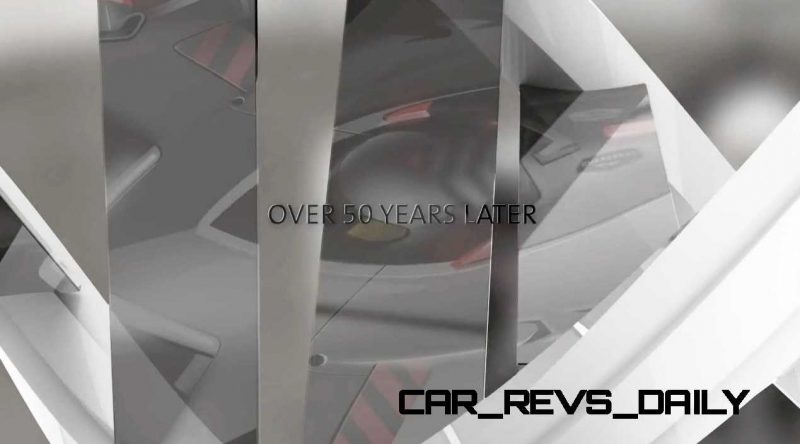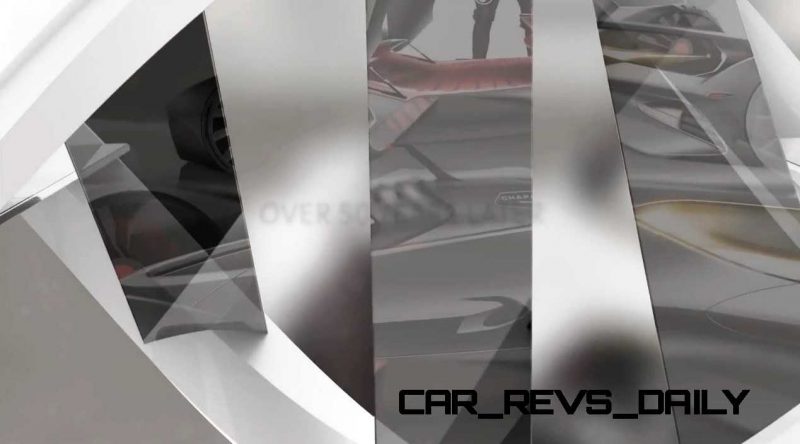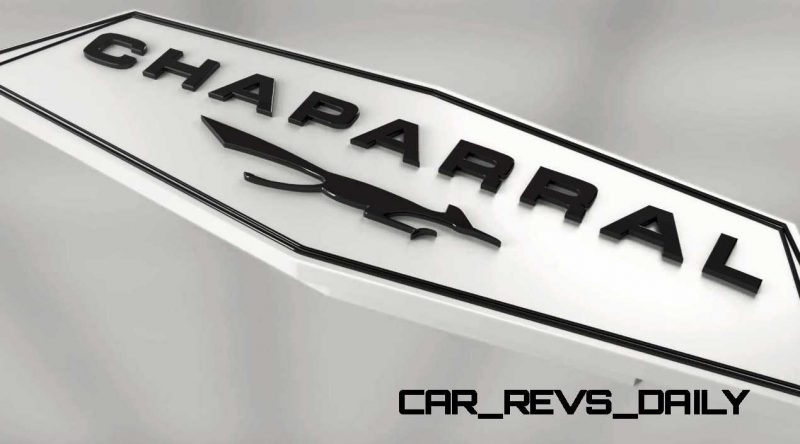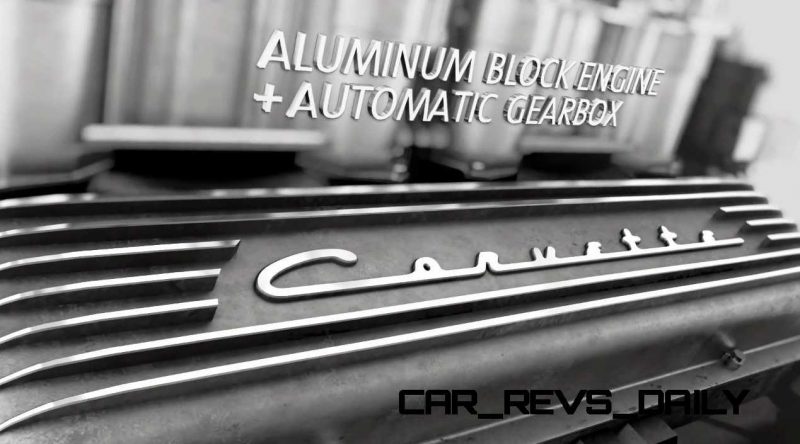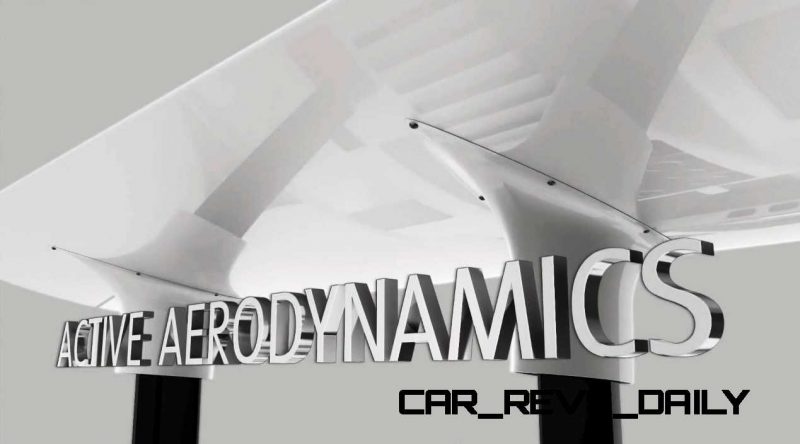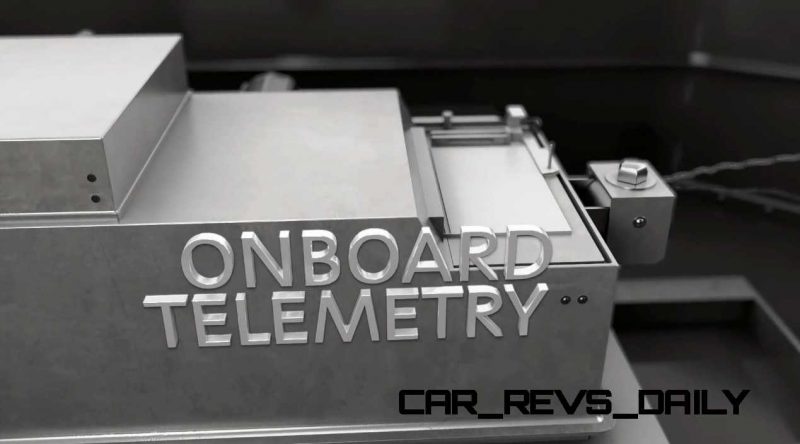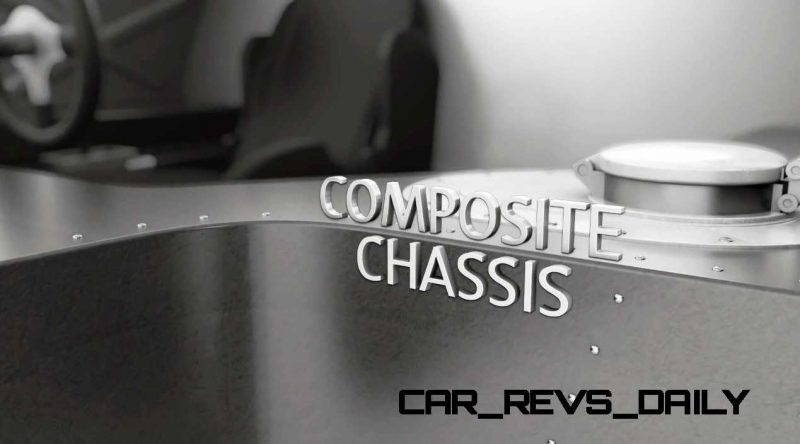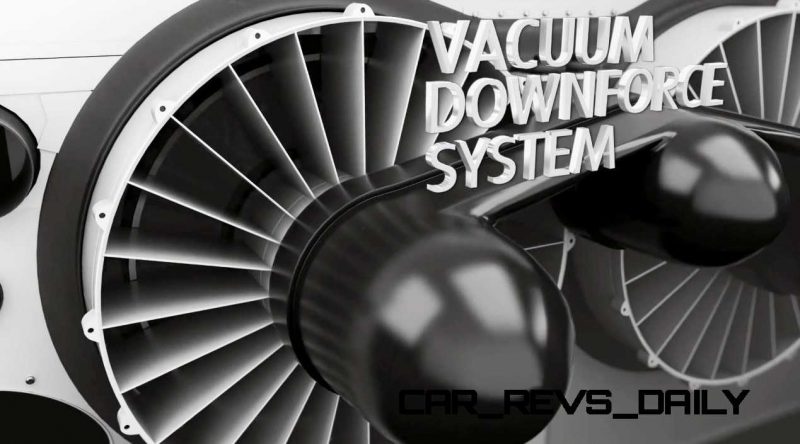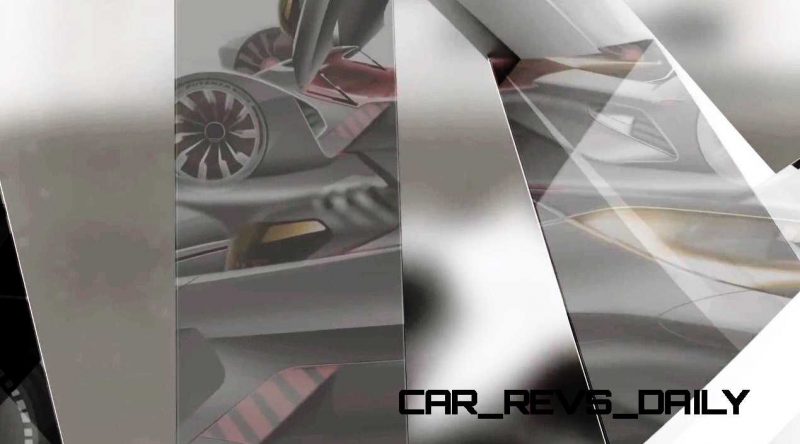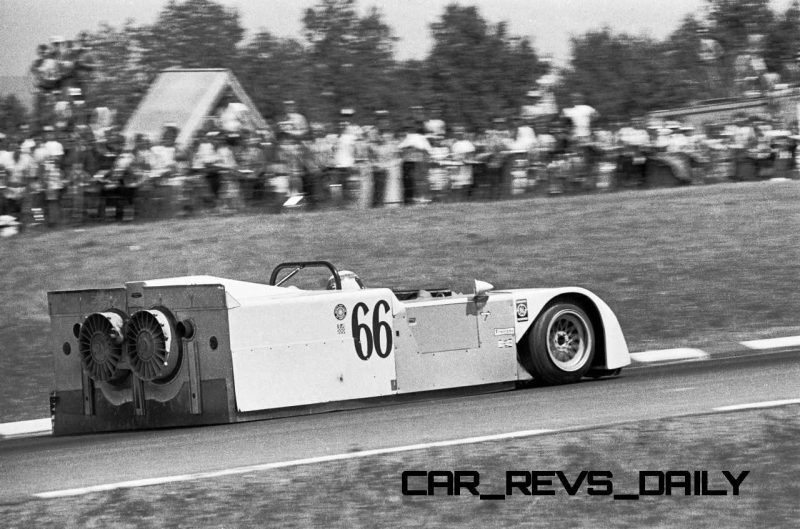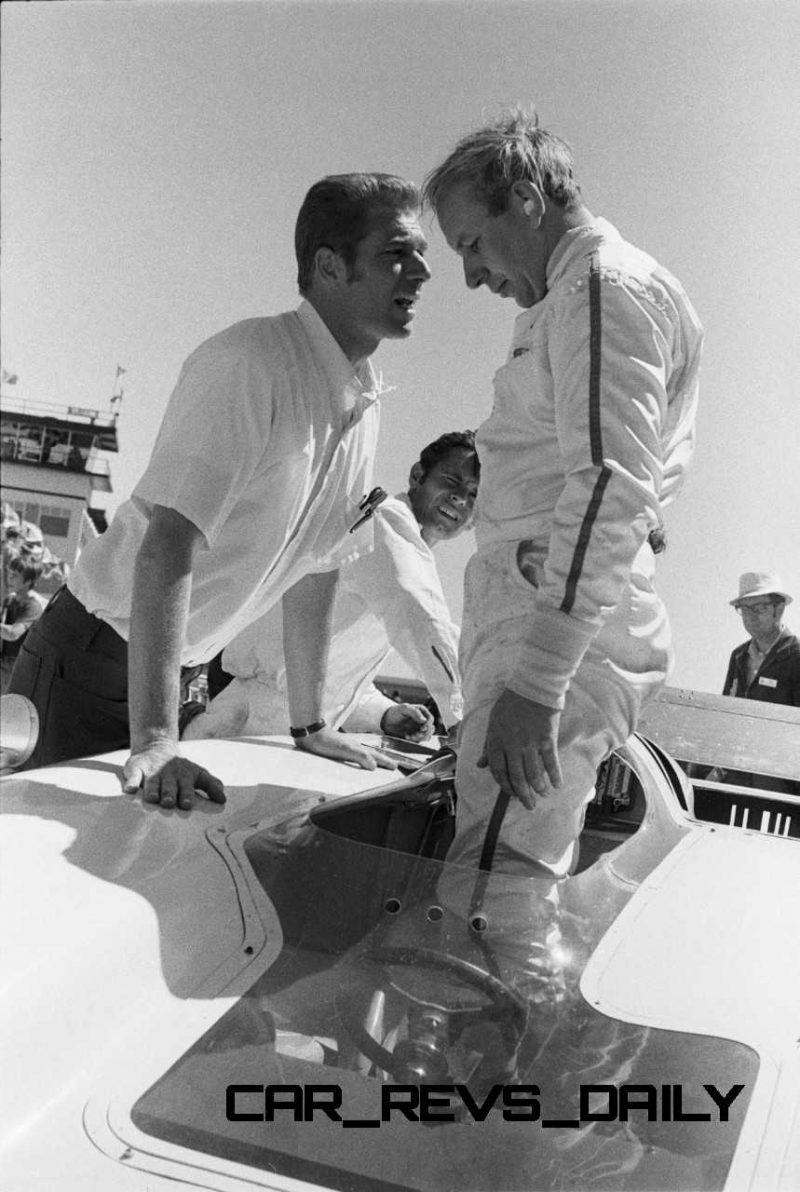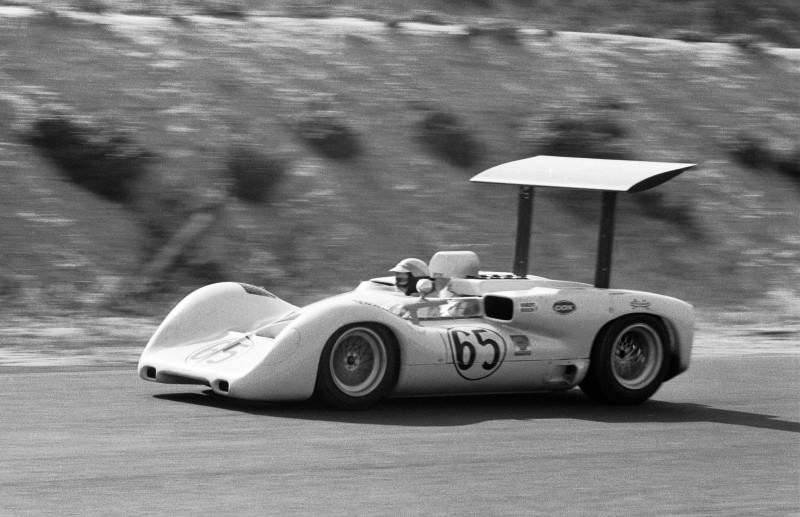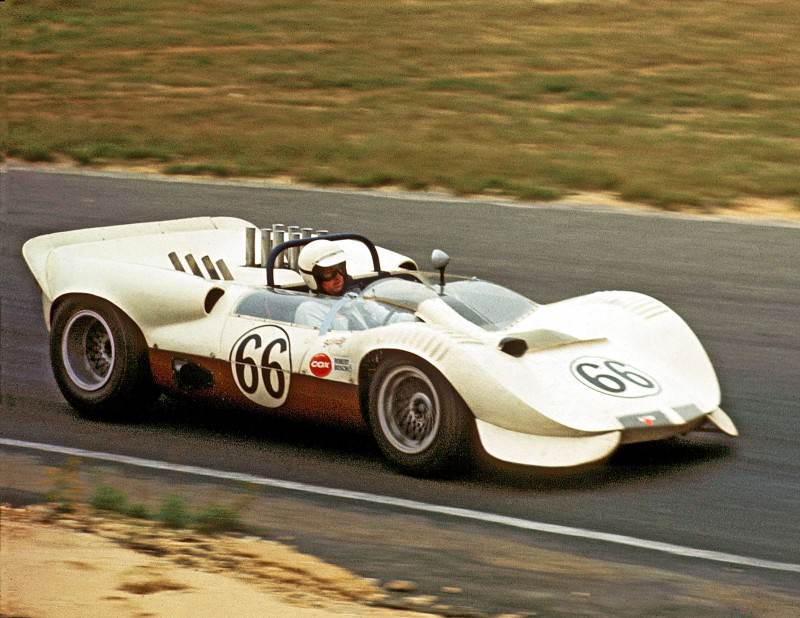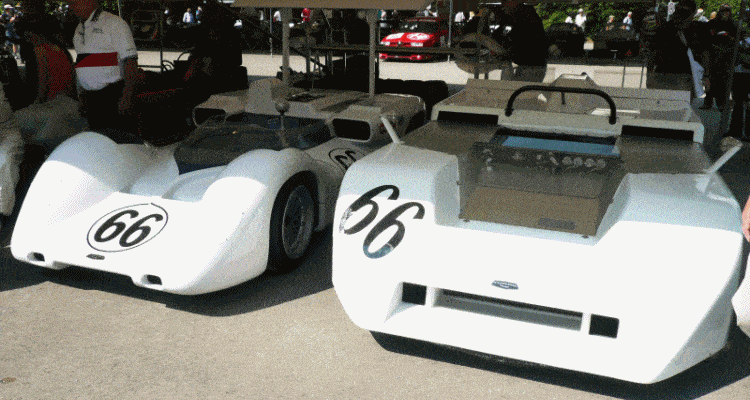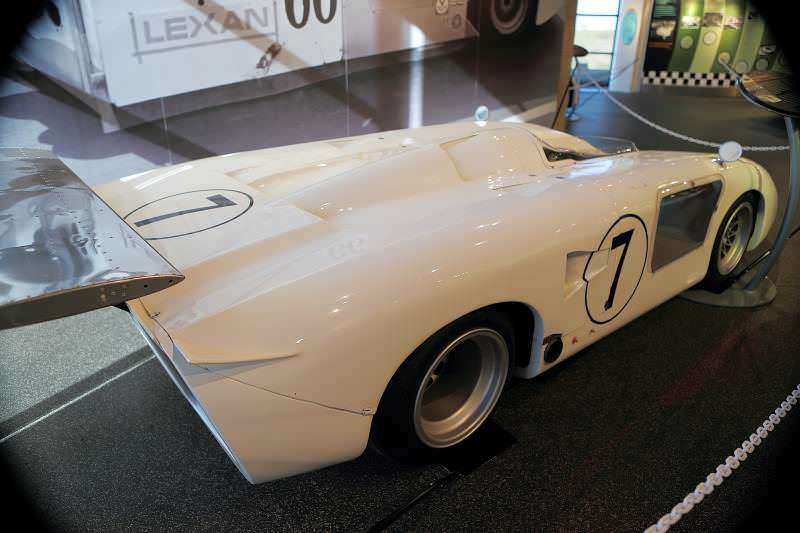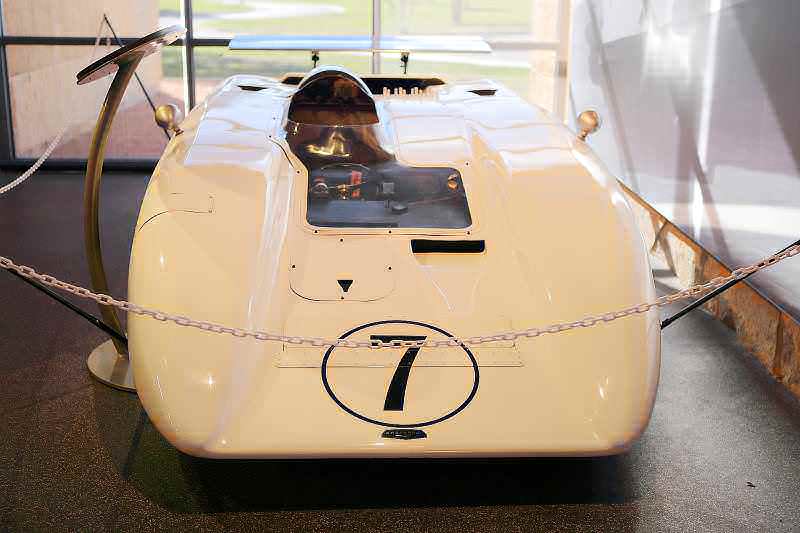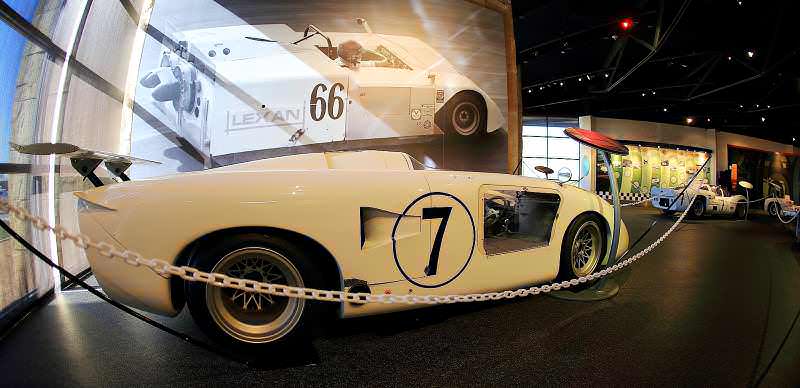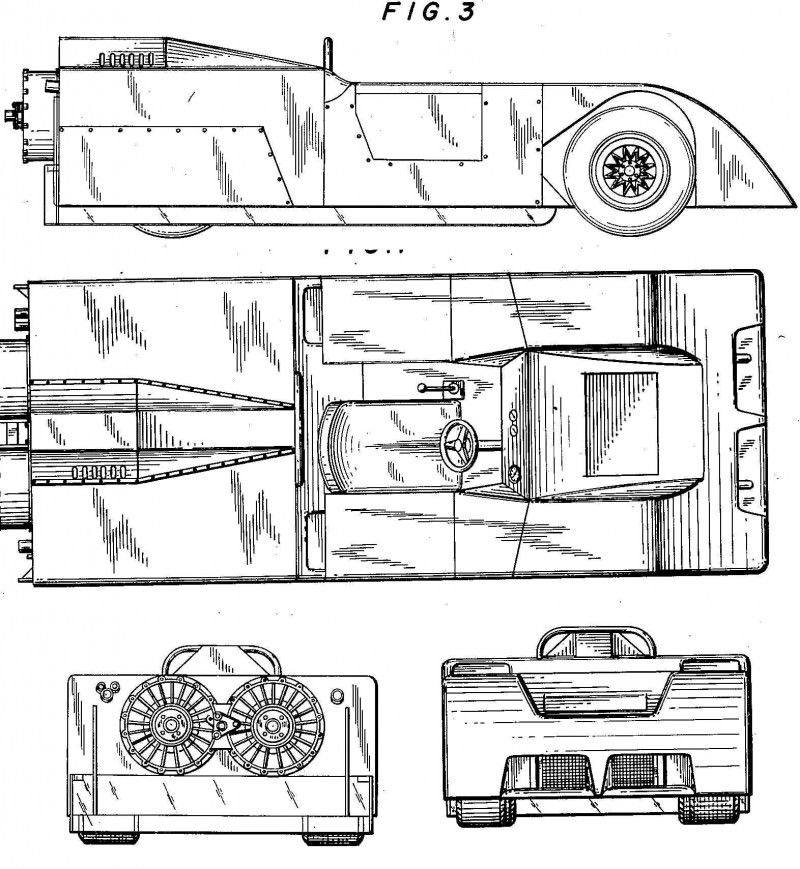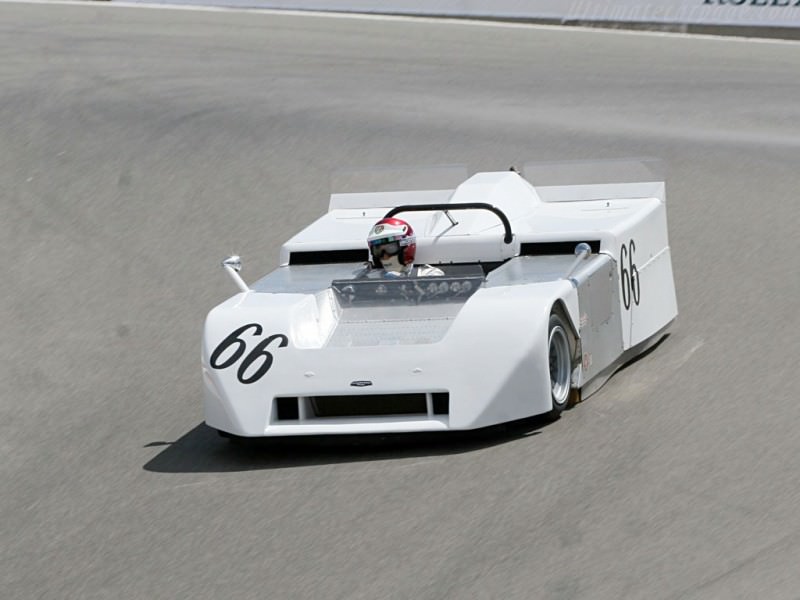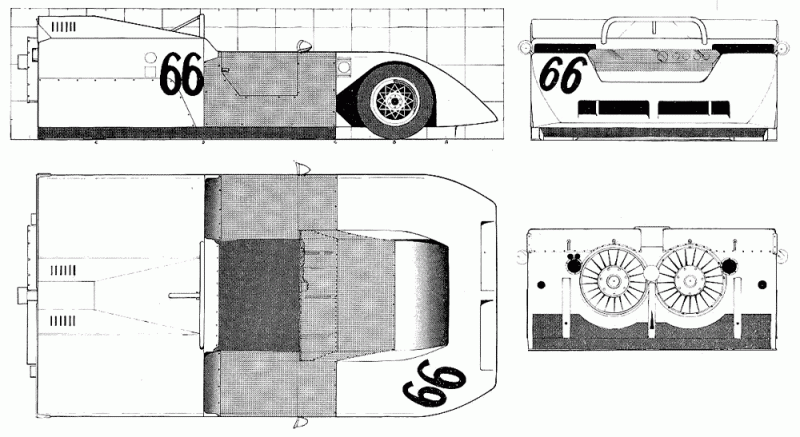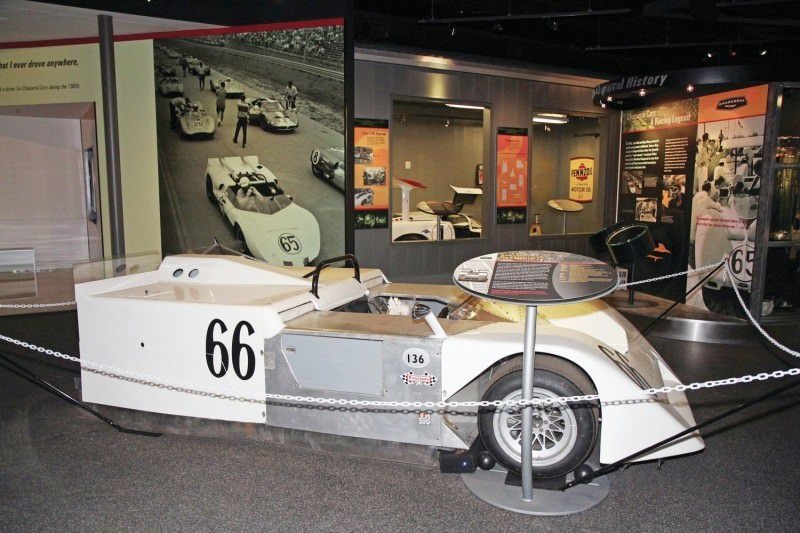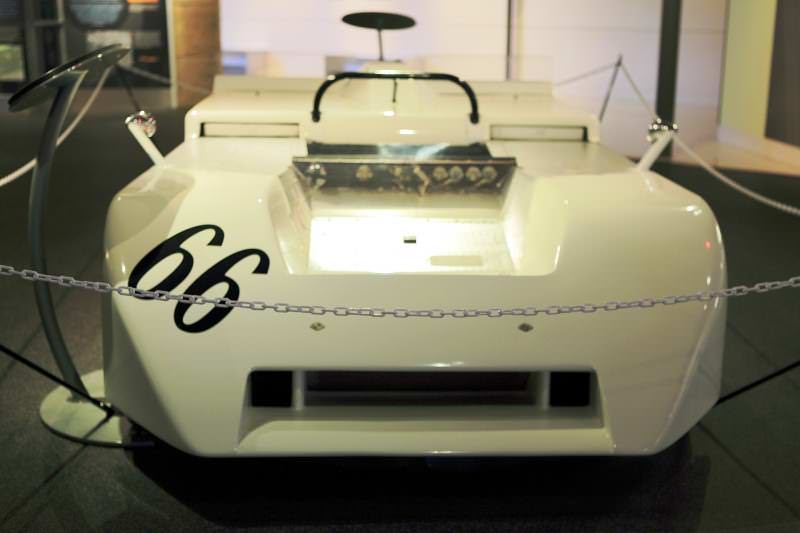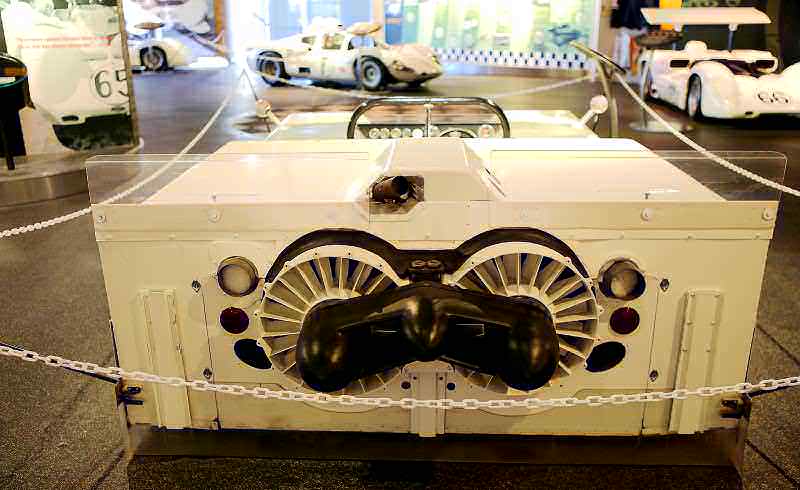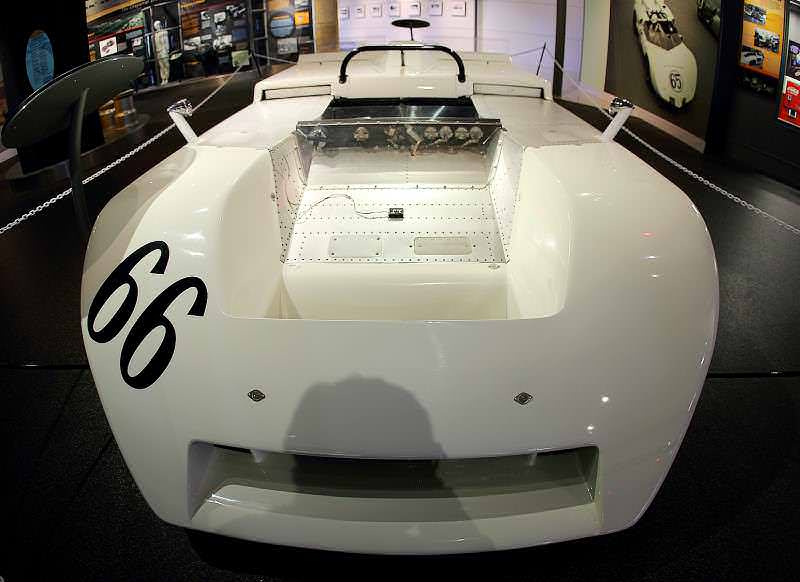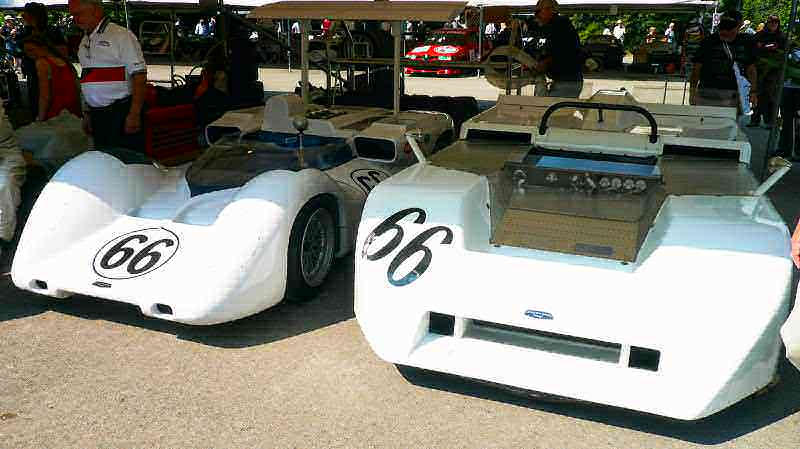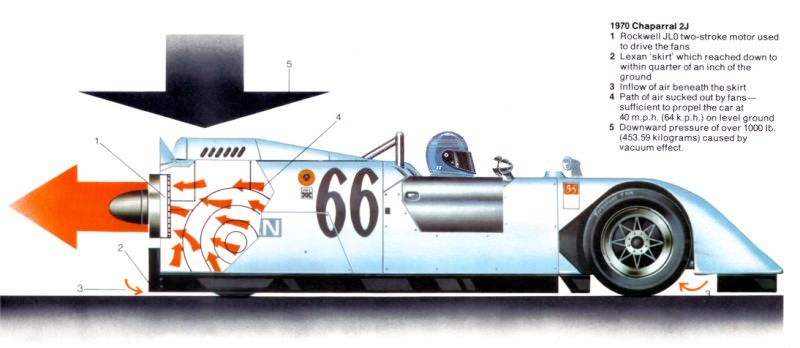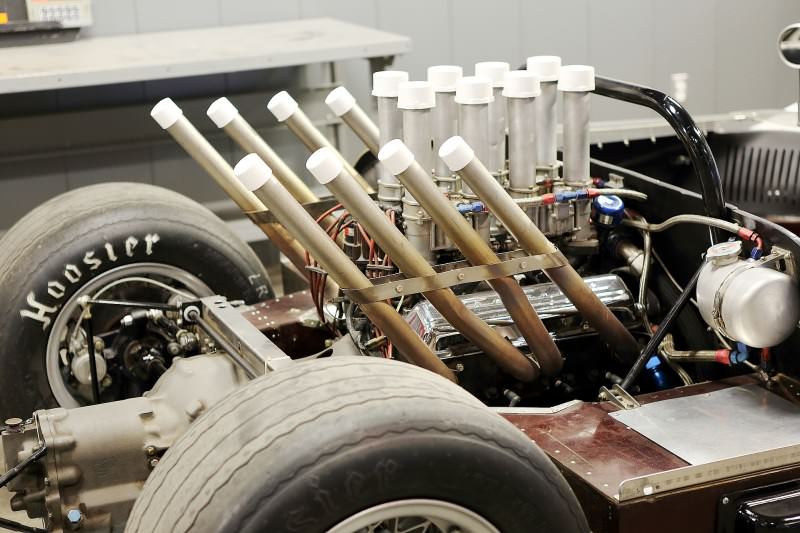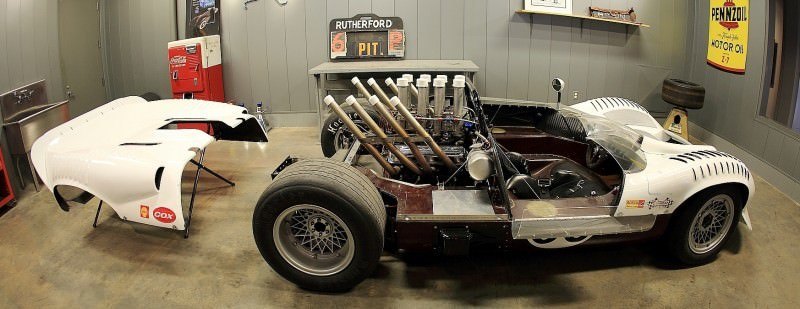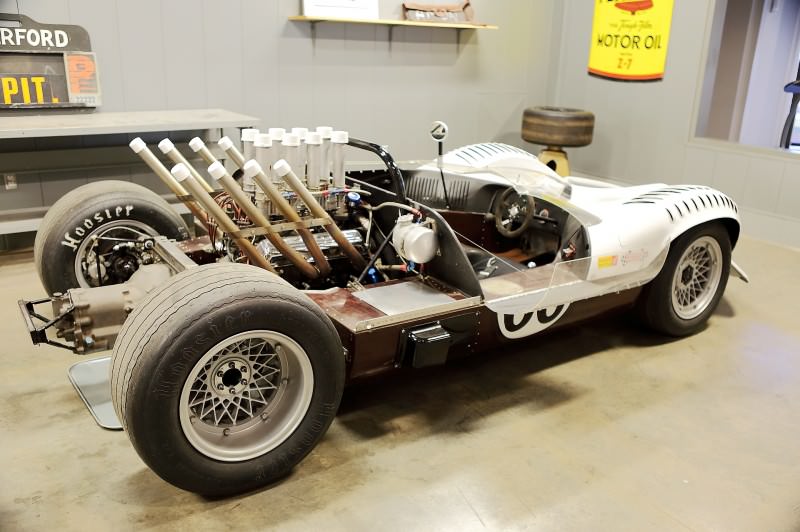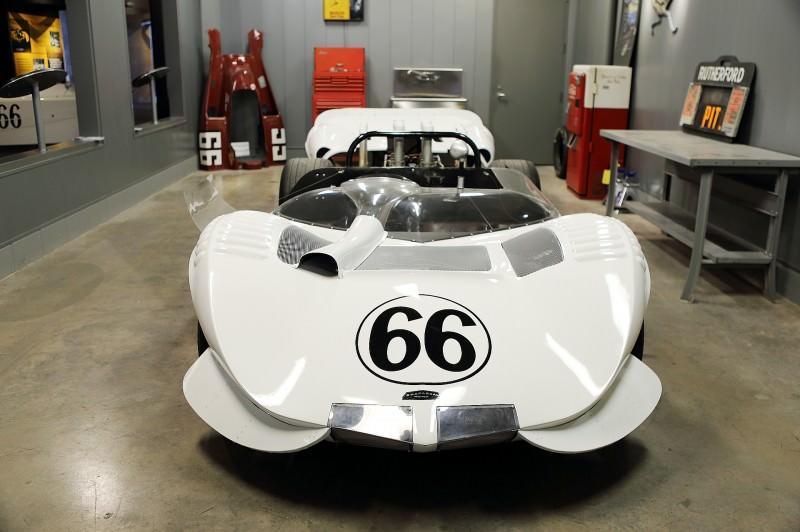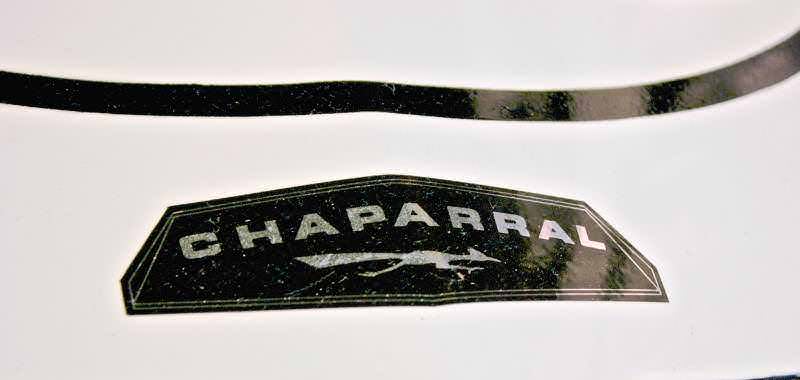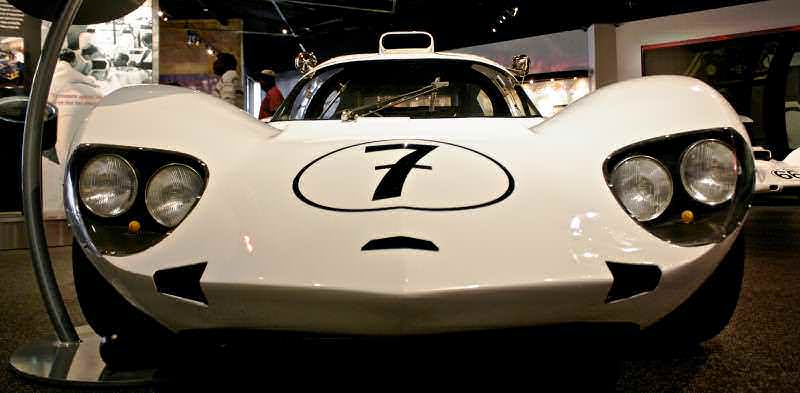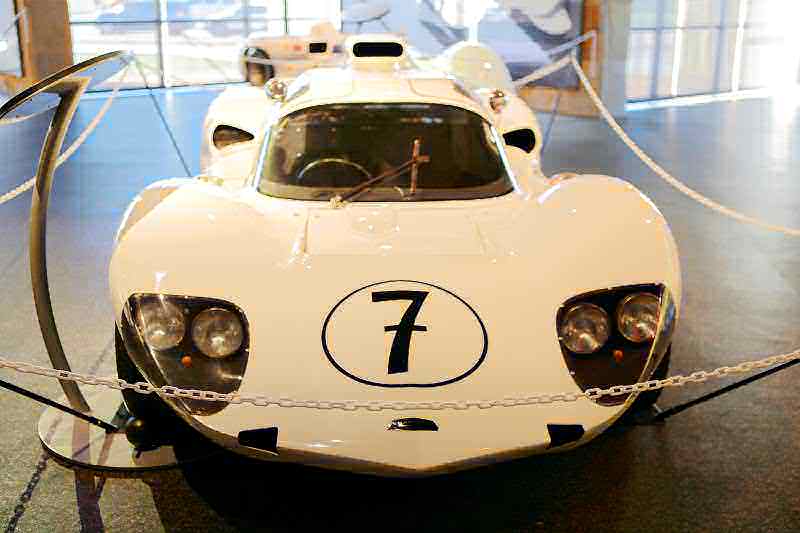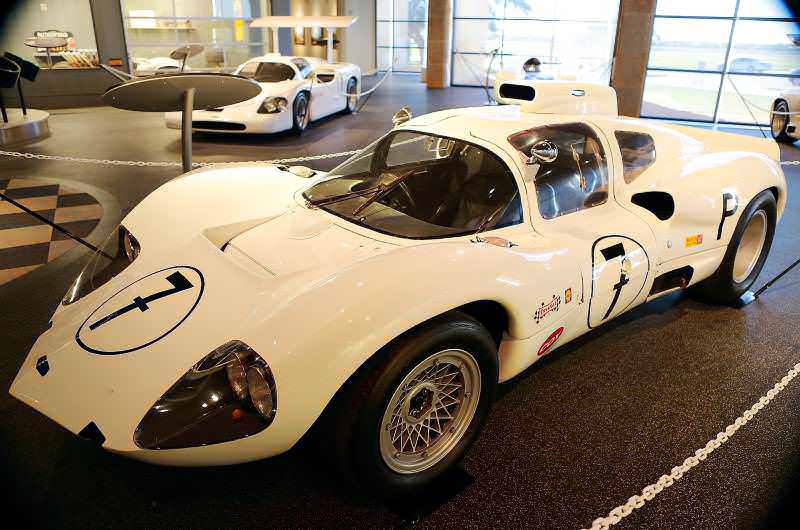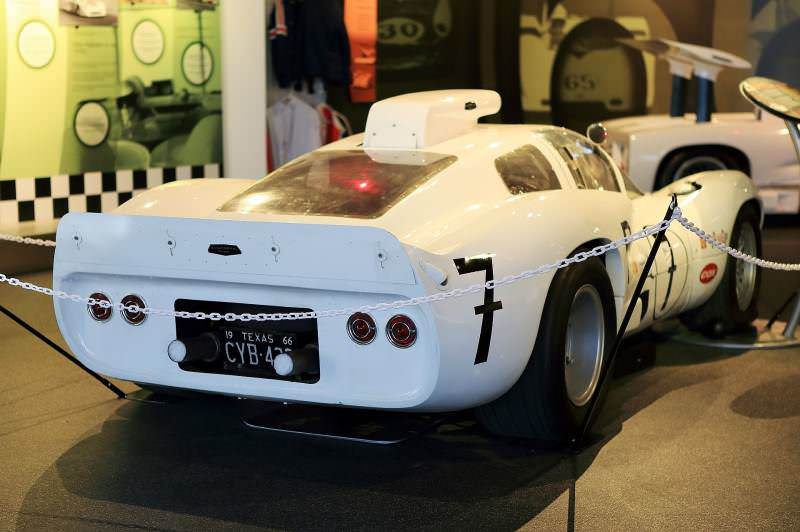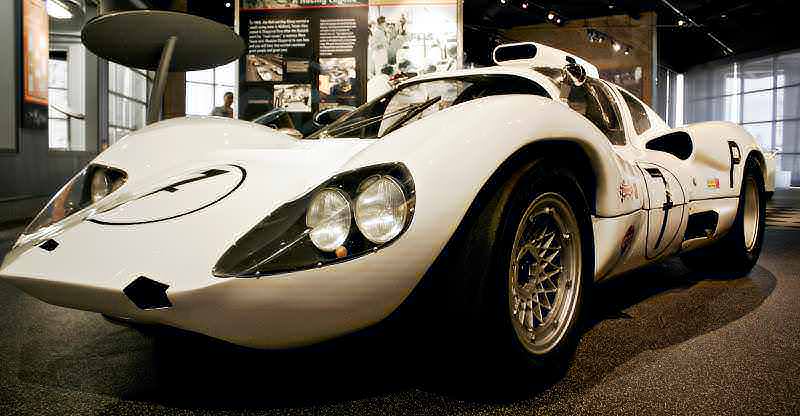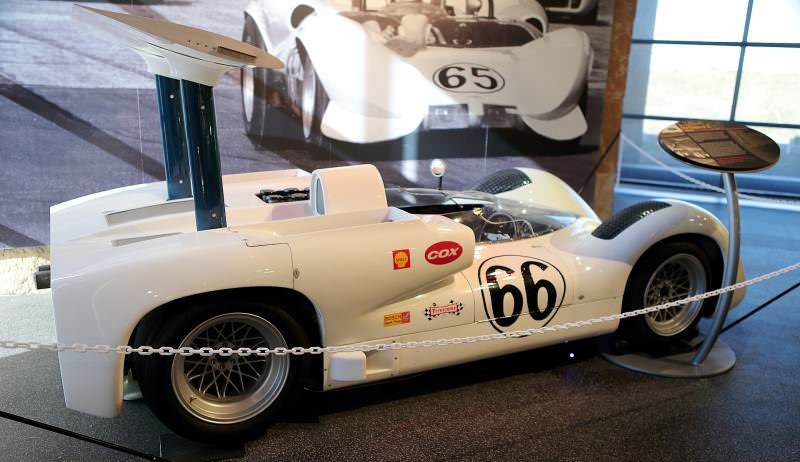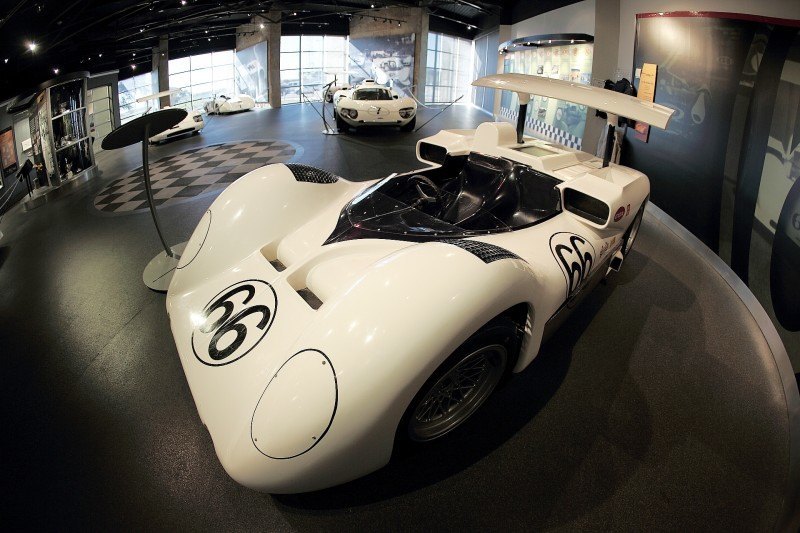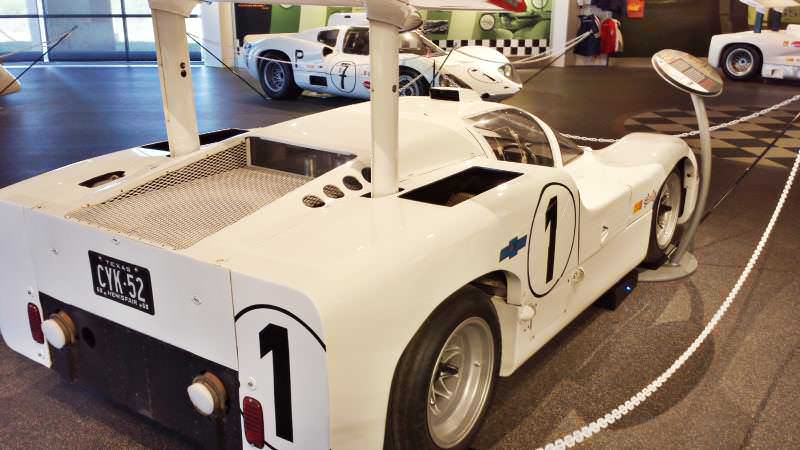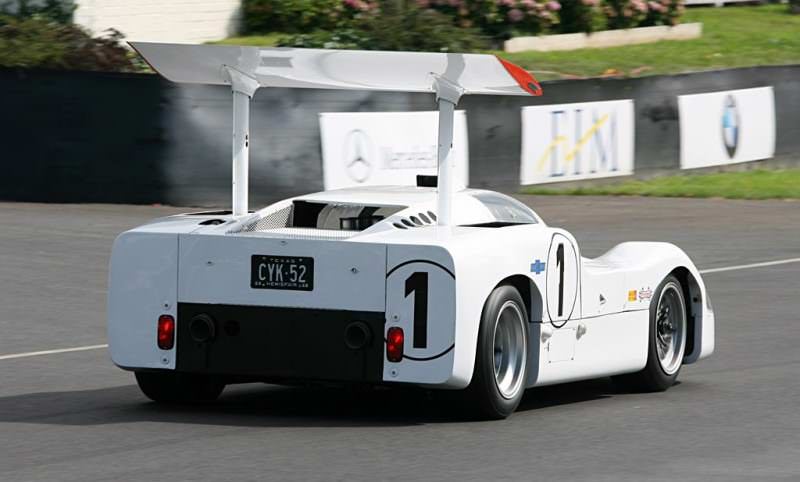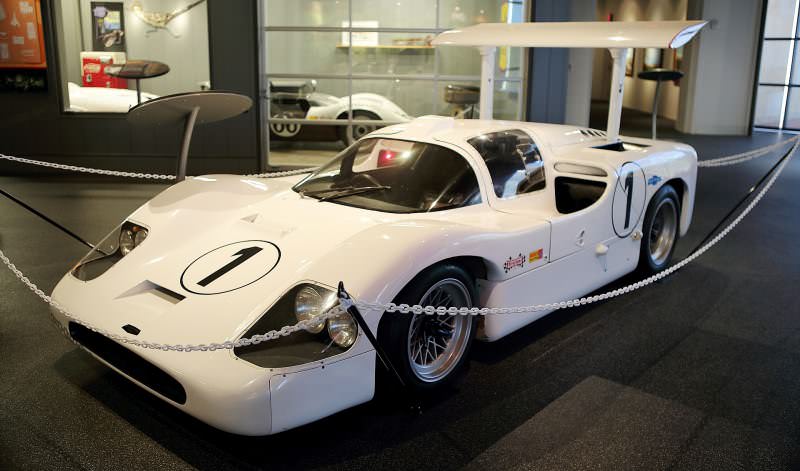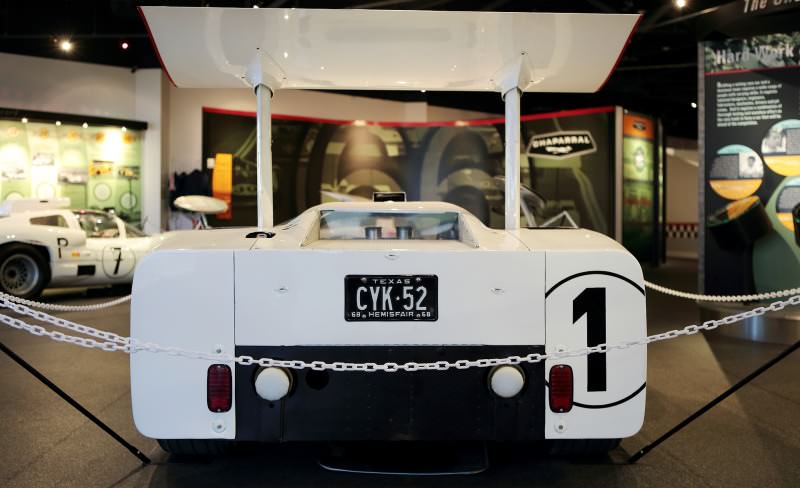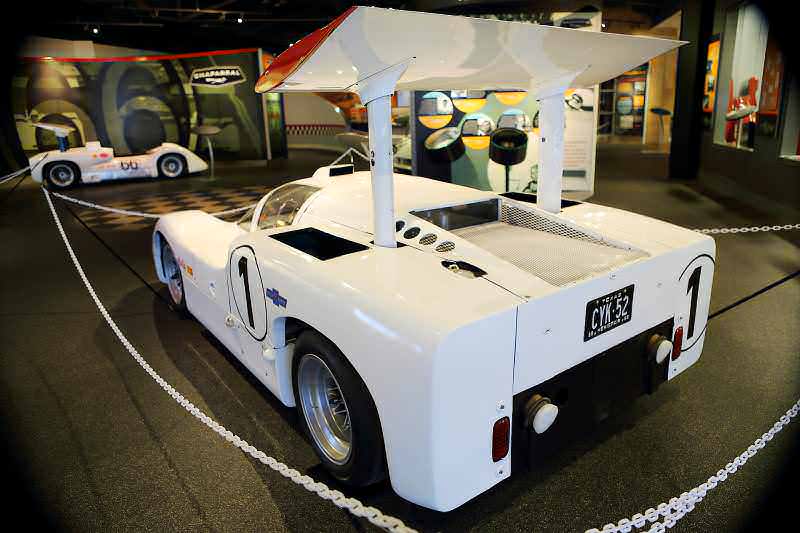We did not know what to think of the first teaser images of the Chevy Chaparral Gran Turismo prototype. Sure, the idea of leveraging Chaparral’s Chevy engines connection was fascinating, but would the vision of GM Design really capture the innovative spirit of these amazing namesakes?
After the official reveal in LA last night – we can only say Yes.
In many ways, the Chevrolet Chaparral Vision Gran Turismo is the best-yet of the 20-strong fleet of racing prototypes developed for the legendary GT6 racing game. It is one of the only to actually throw out all conventional limitations of racecars.
After all, this is a fantasy series — why not indulge with a look perhaps 50 years into the future versus the 5-year look of the VW and BMW entries, or the 10-year future perspective of the Aston and Nissan concepts.
For the Chaparral 2x — this revolution in design starts right in the driver’s seat — where we see the demo model lay flat with her head and Bell helmet only inches above the overall nose of the car. This flying layout is the true epitome of future speed – and one designers of fighter jets have longed to implement versus the traditional rump-down seating layout.
DEBUT VIDEO
Gives me chills – even after watching thrice already!
The skeletal design of the 2X is a lovely flowing surface of surpport structures and bodywork as the monocoque chassis, with laser propulsion delivering a searing sprint to 60-mph in just 1.5-seconds.
The real beauty and elegance of the design comes in the four-wheel-steering system and the thrust-vectoring aerodynamic surfaces. These eight areas of the Chevy Chaparral 2X are the true nod to the brilliance and innovation shown by Chaparral — with active planes changing height and shape to deliver additional grip as needed around Le Sarthe and other GT6 racetracks.
The overall thoroughness of the concept makes it an instant hero in the car world — and makes us long for the future of racing.
With cars like the Chaparral 2X VGT, the speed achieved will be limited only by the processing power of the human brain itself. Imagination and brilliant ideas put to the track — the 2X is the best and most thought-provoking VGT concept yet.
Excellent. May need to dust off the PS3 to see how the 2X races in the game!


These first 12 photos are the official press shots. The ones after are screencaps of the video above – in chronological sequence order.
Chevrolet Chaparral 2X Vision Gran Turismo
Chevy Chaparral 2X VGT
Thrilling news from Chevrolet! The GM Design entry to the Vision Gran Turismo series will be a Chaparral-inspired racer called the 2X VGT.
Set to debut in LA on Wednesday of this week — we are thrilled to see how Chevy has evolved the Chaparral racers’ world-beating aerodynamics for the 21st century!
Chevrolet Chaparral 2X Vision Gran Turismo
Previews
CHEVROLET TO SHOW CHAPARRAL VISION GRAN TURISMO CONCEPT
13/11/14
Boundary-pushing, Chevy-powered race cars changed motorsports design
DETROIT – When racers Jim Hall and Hap Sharp founded Chaparral Cars in 1962, few could have guessed how they would shake up the conformities of the racing world – and fundamentally change it.
Through pioneering applications of aerodynamics and aerospace technology, and a partnership with Chevrolet Research and Development, Chaparral Cars advanced the science of racing cars. It also triumphed on the track over well-established sports car companies from around the world, using Chevrolet horsepower.
It was that spirit of innovation that inspired the Chevrolet Chaparral 2X VGT concept race car developed for the Vision Gran Turismo project, which celebrates the 15th anniversary of PlayStation® racing game Gran Turismo by inviting manufacturers to give fans a glimpse into the future of automotive design. It will debut at the Los Angeles Auto Show, Nov. 19, and gamers will be able race the Chaparral 2X VGT following the release of an online update for Gran Turismo 6 during the holiday season.
“Jim Hall and Chaparral blended the art of racing with science in an unprecedented way, changing the sport forever and inspiring a new generation to experiment with aerodynamics and unconventional materials,” said Mark Reuss, GM executive vice president, Global Product Development, Purchasing and Supply Chain. “His race cars were four-wheeled physics projects that proved innovation – and a strong Chevy race engine – could drive you to the winner’s circle.”
GM’s Advanced Design Studio, with input from Jim Hall, designed the Chevrolet Chaparral 2X VGT concept.
“It will serve as an example of what our designers are capable of when they are cut loose, no holds barred,” said Ed Welburn, vice president of GM Global Design. “A fantasy car in every sense of the word.”
The first Chaparral, a conventional, front-engine race car, was built by Dick Troutman and Tom Barnes in 1961. In 1962 Jim Hall and Hap Sharp – who had purchased one of the original Chaparral racers – formed Chaparral Cars, Inc. and immediately began the design and construction of Chaparral 2, a mid-engine car with an aerospace-inspired semi-monocoque fiberglass chassis. It was powered by a 327-cubic-inch Chevrolet small-block V-8 engine and would later incorporate an innovative torque-converter transaxle.
In its first race at Riverside, in 1963, Hall qualified the Chaparral 2 on the pole position and set a track record in the process. In 1964, he won the United States Road Racing Championship (USRRC) and, in 1965, the Chaparral 2 scored its biggest coup on the racetrack, winning the prestigious 12-hour race at Sebring – upsetting historically dominant international teams.
Chaparral Cars soon partnered with Chevrolet Research and Development to help develop the pioneering methods and materials Hall envisioned, including the composite monocoque chassis, lightweight-alloy powertrain systems, automatic transmissions for racing and progressive, active aerodynamics. The partnership also spawned ground-breaking vehicle data acquisition technology.
In 1966, Chaparral introduced the radical 2E race car for SCCA’s Can-Am series. With a large, high-mounted wing to produce downforce, it represented a milestone in aerodynamics applied to race cars, providing as much as 240 pounds of downforce at 100 mph. Phil Hill and Hall scored a 1-2 finish that year at Laguna Seca. A year later, the Chaparral 2F, a high-winged coupe build for World Championship Endurance competition, set the fastest lap in five of the eight races that season.
Hall’s pursuit of handling-enhancing downforce, which allowed a race car to enter and exit corners faster, while ensuring high-speed stability on the straights, reached its zenith in 1970, with the introduction of the radical Chaparral 2J. In addition to a thundering Chevrolet big-block V-8 engine, it featured a separate motor to drive a pair of fans that exhausted air beneath the car, essentially producing suction-derived downforce.
The Chaparral 2J’s unconventional, fan-driven downforce system was as effective as it was controversial. In four races it grabbed three pole positions – and then it was banned by the race series’ sanctioning body.
Hall and Chaparral continued racing throughout the 1970s, including the 1970 season of the Trans-Am Series, when Hall drove a Chaparral-prepared Camaro Z-28. The company scored a win at the 1978 Indianapolis 500, with Al Unser Sr. driving a Chaparral-prepared Lola racecar. In 1979, Chaparral built its own Indy car, the 2K, which powered Johnny Rutherford to the Indianapolis 500 win in 1980, along with the USAC and CART series championships that year.
The Chaparral 2, 2D, 2E, 2F 2H, 2J, and 2K are displayed in the Chaparral Gallery of the Permian Basin Petroleum Museum in Midland, Texas.
About Chevrolet
Founded in 1911 in Detroit, Chevrolet is now one of the world’s largest car brands, doing business in more than 140 countries and selling more than 4.9 million cars and trucks a year. Chevrolet provides customers with fuel-efficient vehicles that feature spirited performance, expressive design, and high quality. More information on Chevrolet models can be found at www.chevrolet.com.
PREVIOUS
Not just these two icons: the Petroleum Museum in Texas has seven amazing Chaparral racecars in their collection.
These are the Chevrolet-powered racecars that changed the face of racing forever: the ideas and innovations represented by Chaparral in its relatively short run at the top of pro racing are still extremely influential today.
The ideas seem simple – but are near-impossible to deliver in full race-winning form.
Jim Hall’s Ideal Chaparral Racecar:
-
Light weight
-
+ High downforce – with wings attached directly to the suspension versus to the bodywork
-
+ Huge power via reliable engine
-
+ Massive grip on long-lasting tire setups
=====
Equals VICTORY!
None other than Bruce McLaren and Gordon Murray were extremely influenced by Jim Hall and his Chaparral cars — but they also reinvigorate everyone who sees their simple execution in the flesh.
These cars are the rarest of the rare. The only reason they are all together, one might argue, is that the Petroleum Museum is in Hall’s home town of Midland, Texas.
But for car fans, this is a godsend. It means they are not locked away in some collector’s garage, but are open and viewable by the public nearly every day.
And for even more thrills? The Petroleum Museum fires them up monthly for a quick spin around the parking lot, to keep them mechanically fresh. You can schedule your trip around these live action exhibit days to get the full Chaparral experience of a lifetime.
Plan your trip now via the Petroleum Museum’s web site, linked below.
http://petroleummuseum.org/
Official Details below from the Petroleum Museum.
Chaparral Cars on Display
Chaparral Gallery Exhibits
Jim Hall – A Racing Legend
Chaparral 2H and 2J
Cars on Display – Descriptions and photos of all the Chaparral Cars
Join the Chaparral Pit Crew Fan Club
Click here to download the Pit Crew Fan Club membership form.
Chaparral Live Drives
Photo credits and copyrights are the property of their respective owners. All Rights Reserved.

Tom Burkart is the founder and managing editor of Car-Revs-Daily.com, an innovative and rapidly-expanding automotive news magazine.
He holds a Journalism JBA degree from the University of Wisconsin – Madison. Tom currently resides in Charleston, South Carolina with his two amazing dogs, Drake and Tank.
Mr. Burkart is available for all questions and concerns by email Tom(at)car-revs-daily.com.

